All News
Leisure Time & Entertainment
Travel tips in Europe
Travelling by train through Europe? Best tips to make your journey a great experience
music, movies and more
It's finally getting warmer and besides the beer garden season, the culture and music season is also starting, this year mainly open air.
The Eulenspiegel Flying Circus in Passau runs until 8 August, with mainly German-speaking artists performing. In the beer garden next to the festival you can enjoy the atmosphere between the rivers with a cool drink.
Here you can find the programme: https://eulenspiegel-passau.de/
The Gern Geschehen Festival near Eggenfelden takes place at the end of August, with music from various bands, a creative market with regional producers and a food market: https://gerngeschehen.eu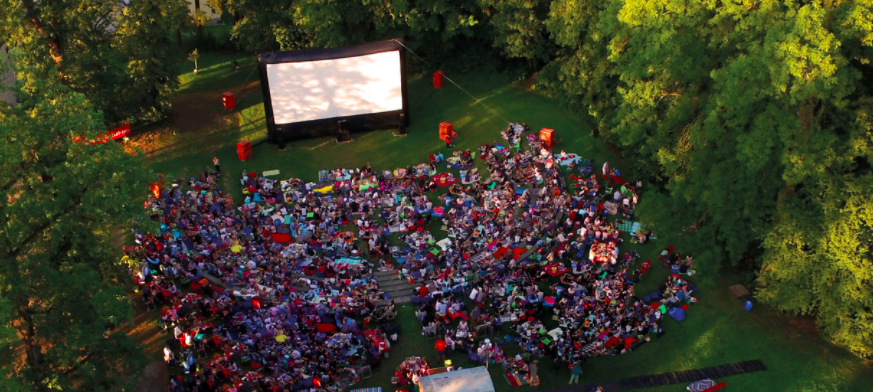
Photocredit • Gerniale: https://www.gerniale.de/de/programm
For the film fans among us, the Gerniale from 21.07 to 31.07 is the place to go. Tickets for
the open-air cinema located in the Schlosspark in Gern are now available, there will be no evening ticket desk. Here you can find the programme:
https://www.gerniale.de/de/programm
The Sommernachtskino in Passau also takes place in July and August: https://www.cineplex.de/filmreihe/sommernachtskino/3516/passau
Of course there are many more events in the region! Information about the events in Pfarrkirchen can be found here:
https://pfarrkirchen.de/aktuelles/veranstaltungen.html
Zauberberg organises also some events in the Passau-Deggendorf-Eggenfelden triangle:
https://www.zauberberg-passau.com/veranstaltungen
In Munich, the culture and environment festival Tollwood closes this WEEKEND so check it out quickly: https://www.tollwood.de/en/tollwood-sommerfestival/
ECRI NEWS • 15.07.2022
Freilichtmuseum Massing
The sun is shining, you have a day off and you are wondering what to do?
Maybe you could venture to visit the open-air museum in Massing. It is not hard to reach: You can go there by train (10 min walk from the station to the museum), by bike (the Rottal bikelane runs directly past it) or by car (parking facilities are available).
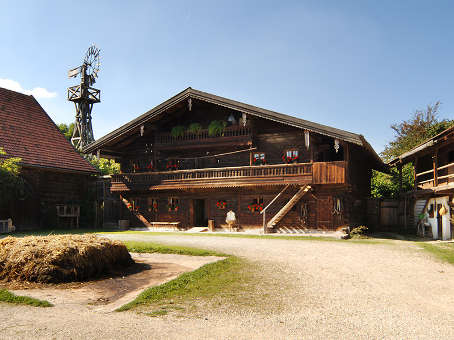
Arriving at the museum you might wonder where it is. Thinking of a museum you imagine one building where you can see an exhibition. But that is not the case in Massing. Here you can see several different buildings, all of them are original Bavarian farms and houses. The oldest house was built in 1611. Besides the unspoilt architecture you can experience how people used to live and work in the Rottal region. The agricultural aspects of the rural live are also represented. There are chicken and pigs and a cottage garden. Furthermore, you can learn something about traditional craftsmanship, e. g. the production of roof tiles, pottering or rope-making. You can also go bowling on an old traditional skittle alley. And if you are hungry after your exciting visit in the open-air museum you can stop for a bite to eat in the museum’s restaurant Museumsstüberl offering traditional Bavarian food.
From May to September the museum is opened every day except Monday from 9 am to 6 pm.
For more information have a look at the museum’s website: https://www.freilichtmuseum.de/massing-open-air-museum-/massing-open-air-museum
Pauline Kreis 10.06.2022
Finally, the 9€ Ticket is here!
For 9 euros, you can travel throughout Germany on local/regional trains for a whole month in June,
July or August. Means everything except long-distance trains.
Please note that there may be different rules depending on the federal state! As always, check the route section in the DB App beforehand to see if the offer also applies here.
And
the ticket is also valid as far as Salzburg in Austria, for example. In this doc you will find the
areas of validity for AT, CH and PL and the valid transport associations in DE.
Bedarfshalt???
There are many on-demand stops (Bedarfshalt), especially on regional services, where you have to let the train driver know in advance that you want to get off! The stops are marked in the DB App.
Can I take my bike with
me?
Normally yes on regional trains, with an extra ticket. But in some trains, bicycle transport is free of charge, which is also indicated in the DB App.
General: FFP2 masks are still mandatory on the train!
BikeStation • Self-Help Workshop
the content has moved here: https://ilearn.th-deg.de/mod/book/view.php?id=306213&chapterid=15440
Beer Gardens in and around Pfarrkirchen
Some of you might wonder what a “beer garden (Biergarten)” even is. The tradition of course originated in “the beer state of Germany”, also known as Bavaria. In the early times of the 19th century, in order to keep the beer cool and good during
the summer months and the fermentation, the brewers stored it in cellars and planted trees to provide shadow. As they weren’t allowed to brew beer during the summer months - due to the fire hazards caused by the equipment needed for brewing
– they came up with the idea to position some tables in the surroundings of the cellars and sell their beer to the people, a “beer garden”. Back then, it wasn’t allowed for the brewers to offer food as well, so the people had to bring their
own snacks.
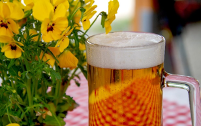 However, nowadays “beer gardens” are mostly also restaurants,
but in some it’s still allowed to bring your own food and just buy the beverages. So, if it’s a nice summer day, you’re done with your tasks for the university, or you want to get a little study break and enjoy some Bavarian or international
food and a beer or any other refreshing drinks, you might want to go to one of the many beer gardens in the region. Don’t worry, even if you don’t like beer, a visit in a beer garden is really nice.
However, nowadays “beer gardens” are mostly also restaurants,
but in some it’s still allowed to bring your own food and just buy the beverages. So, if it’s a nice summer day, you’re done with your tasks for the university, or you want to get a little study break and enjoy some Bavarian or international
food and a beer or any other refreshing drinks, you might want to go to one of the many beer gardens in the region. Don’t worry, even if you don’t like beer, a visit in a beer garden is really nice.
Next you can see some suggestions for restaurants in and around Pfarrkirchen, which have a “beer garden”:
Schwaibacher Hof
The Schwaibacher Hof is situated near Bad Birnbach and easy to reach by train or if you’d like to combine your visit in the “beer garden” with a little bike tour, that’s also possible. They’re usually open from Thursday till Sunday. If you like “Schnitzel” that’s the right address for you, as they normally offer a wide range of different ones for their guests. Their opening hours are Thursday 11 am - 14:30 pm and 16:30 pm – 21 pm; Friday: 11 am - 14:30 pm and 16:30 pm – 21 pm; Saturday: 11 am – 21 pm; Sunday: 11 am – 20 pm. If you’re interested you can visit their Facebook page, where they upload the menu for the week/month: https://www.facebook.com/Schwaibacher-Hof-538261486272617/
Gasthof Schachtl
This restaurant has a long tradition and is situated in the middle of Pfarrkirchen. The cuisine is typically Bavarian and ranges from snacks like cheese plates, sausage salad to different variations of “Schnitzel”. Of course, they also offer some desserts to satisfy the ones who have a sweet tooth. If it’s a nice day you can enjoy something from their menu and a cold beer or antialcohol refreshments in their beer garden surrounded by old chestnut trees. They’re usually open from 11 am till 24 am from Wednesday till Sunday. https://gasthof-schachtl.de/
Gasthof zur Mühle
Another option is situated in Bayerbach, which you can reach easily by train or if you rather want to get some fresh air and exercise you can combine your visit with a cycling tour. In their beer garden you can enjoy typical Bavarian snacks, like for example “sausage salad” and “Schnitzel”. However, if you don’t desire the traditional Bavarian food options, they also offer some pasta, salads, and burger. Their opening hours are Wednesday till Friday from 3 pm, and on Saturdays and Sundays from 9 am on. https://www.gasthof-zur-muehle.de/de/kulinarik/biergarten.html
Place for a picnic – near the Reichenbergkapelle
The Reichenberg castle, which was demolished in the 17th century, and with the remaining stones a restaurant was built. This building is still there and can be found in Pfarrkirchen, Herzog-Heinrich street 5. Unfortunately, the restaurant and beer garden with the beautiful views was closed in 2019. However, maybe you want to walk there, to enjoy the views of the region and bring a blanket, some snacks, and beverages.
There are also some international restaurants in Pfarrkirchen, which offer a nice terrace where you can enjoy their culinary offers:
La Boveda
The Mexican restaurant, which exists already since over 20 years, is situated in the middle of Pfarrkirchen. They don’t only offer a nice indoor area with its vaulted ceilings, but also a terrace/garden, where you can try and enjoy Fajitas, Enchiladas, Cocktails and of course also beer and anti-alcoholic beverages. They’re open from Wednesday till Sunday, 6 pm-10 pm. https://www.laboveda-pan.de/
Miró
The Italian restaurant can be found at the “Pollozek” in Pfarrkirchen, their opening hours are from Monday till Saturday from 9:30 am – 11 pm. Their “Terrazza” is kept in a Mediterranean style where you can immerse into the Italian cuisine from pizza to pasta and many other things. https://www.miro-pfarrkirchen.de/
Pizzeria Fiume
This Italian restaurant can be found near Norma in Pfarrkirchen. They offer typical Italian food from Monday till Sunday 10 am – midnight, which you can eat on their nice little terrace in their courtyard. https://www.deinrundgang.de/projekt/ristorante-pizzeria-fiume/skinned/
Of course, there are many more options in the surroundings of Pfarrkirchen, if you need more recommendations and options, you should ask the locals you know, for their recommendations regarding restaurants with nice beer gardens, as they often
have some insider tips. I indeed did the same for the purpose of this article.
Making a barbecue in and around Pfarrkirchen
In public parks in Bavaria, a barbecue is only allowed if there are signs which say so, in nature reserves it’s strictly forbidden. If you make a barbecue where it’s not allowed, you might have to pay a fine. So, you have two options in the
region of Pfarrkirchen, where you can enjoy a barbecue.
However, there are also some things which have to be considered:
- Only use areas which are designated for barbecues and ensure, that the grill has a secure footing
- Only use safe grill lighters and don’t leave the barbecue unattended
- Don’t dispose the ashes when they’re still hot
- Pay attention to the wind, as fire sparks can increase the risk of fires
- It’s best to have a bucket of water prepared, in any case of emergency
Rottauensee
Several barbecue areas are available around the Rottauensee in Postmünster. If you want to make a barbecue, there you firstly have to register it. Therefore, you have to call the following phone number 08561/306-23 (association for the Pfarrkirchen-Postmünster recreation area).
Your balcony or garden
It’s not forbidden by law to make a barbecue on your balcony. However, you should have a look at your rental agreement and the house rules, as sometimes the landlords write down some restrictions. Sometimes, it’s forbidden to use charcoal barbecues, but the use of electric and gas grills is allowed. If you’re not sure about something, it’s probably best to ask your landlord about the regulations. If you live in a flat with several people you should also ask your roommates if it’s ok for them as well and maybe even your neighbours when you fear that the smoke could disturb them.
How to make a barbecue more sustainable?
1. Sustainable grill charcoal and alternatives
Buy grill charcoal from native trees (e.g., beech) as otherwise it’s often from other countries in South America or Africa where the wood needed for it, is sometimes even lumbered illegally. But there are even more things you should pay attention to when
buying charcoal, as there are some wood seals which can tell you, that the coal is rather “good”:
- FSC (recommended by NABU & BUND),
- PEFC (recommended by the Ministry of Agriculture, but not by NABU & BUND)
- Naturland (recommended by NABU & BUND)
There are also some alternatives to the classical wood charcoal, which are out of agricultural waste, like for example charcoal out of the kernels of olives, corn cobs, shells of coconuts or grape wines. However, those are quite expensive,
and therefore not really interesting for our student budget and you mostly have to order them online, which isn’t that sustainable. Additionally, you shouldn’t use any chemical barbecue lighters as they are bad for the environment, rather
use natural lighters.
2. Different grills/barbecues
There exist many different types of barbecues, which all have their ups and downs.
Charcoal barbecue- As already stated, it’s important, to at least look for the seals and make sure, that the wood used for the charcoal isn’t coming from far away tropical trees
- You could use a “globe/kettle BBQ”, as they have a lid. Thereby the inside reflects the heat and your vegetables or/and meat get cooked gently and evenly
- Many portable options
- Easy to switch on/off and to regulate the heat, those makes it possible to use only that much energy you really need
- Not portable
- If you have green electricity and would operate the barbecue with renewable energy, this one would have the best carbon footprint
- Easy to switch on/off and to regulate the heat
- makes it possible to use only that much energy you really need
- Uses propane, which doesn’t belong to the renewable energies
- Right now, the selection of those is limited and some reviews of such barbecues, state, that it’s more like a food steamer
Moreover, it’s better to buy a reusable barbecue, as the cheap one-time use roast, to prevent the waste. Another thing you can do is, to buy instead of aluminium foils, reusable grill pans and containers, which you can for example use for cheese or potatoes. Thereby you can reduce the waste you’re accumulating.
3. What to put on your barbecue?
Now, that we’ve discovered different barbecues and types of charcoal, we have to think about, what we want to eat and put on our barbecue to make it more sustainable. If you want to have meat, you should pay attention to, where it’s coming from. It’s advisable, to buy from a local farmer or butcher, where you can see and/or ask how they keep their animals. For sure, that’s a bit more expensive than buying the cheap meat options from the local discounter, however, it’s not only better for the environment but also for you and your conscience. Yet, it doesn’t always have to be meat, a barbecue can also be awesome with vegetables. There it’s best to use the ones which are in season. Right now, you could use asparagus till the middle of June, mushrooms, potatoes, tomatoes, and onions nearly the whole year. Moreover, are zucchinis and sweet corn options during the summer months. So, like you can see, there are many vegetable options which can be bought from native produce and on the internet, you can find lots of recipes and ideas for vegetable barbecues. Bavarian season calendar vegetables and fruits (unfortunately it’s in German): https://www.kern.bayern.de/mam/cms03/shop/flyer/dateien/200407_final__kern_saisonkalender_barrierefrei_neu.pdf
A tale of Easter in three traditions
Mary, from Egypt
Hello! What´s your name and where are you from?
I am Mary and from Giza, near Cairo, in Egypt.
When do you celebrate Easter?
This year we celebrate it on the 24th of April. We are kind of one week behind, as we are Orthodox Christians and follow another calendar.
When do you start with the celebration of Easter?
Palm Sunday. Since that moment, every Sunday is a specific celebration, and Palm Sunday is when we start with the real celebration
For how long do you celebrate the pre-easter period, the lent?
Yes, we celebrate Easter on its own, but in the period before it, we start 55 days before, and we fast during those 55 days.
What does this fasting consist of?
You cannot eat anything from midnight till 3 p.m. So, we fast during the morning. And when we eat, we follow a type of “vegan” diet, with no animals products.
When do you break the fast?
We break it when the clock strikes midnight on Saturday, and it turns into Sunday early morning.
Do you celebrate the arrival of midnight?
I know some people do it differently, but for me and my family, we do. It’s a celebration that starts on Saturday when we start cooking and preparing everything, and then at 12, we celebrate the arrival of Easter Sunday and the break of our fast.
What type of meals do you eat to break the fest?
Well, everything we couldn´t eat during that period! Hahah… We eat meat, chicken, fish because we couldn´t eat them for a long time. Soups, etc. Peppers filled rice.
Fasting like this is not a must, in some other Christian churches I know they do not do this, but for us orthodox is like this.
Which days are bank holidays in your country during this period, or which days are considered days “off” in your country?
There are no official Easter holidays in my country, but Easter Sunday is a day that the Christian community can have it off if they wish so.
On the following day, Easter Monday, this year we all have a day off, no matter your religion, as it is an official bank holiday in Egypt, but completely unrelated to Easter.
How do you celebrate the days coming up to Easter? What do you normally do on these days, etc?
Each Sunday is a different celebration, also each day has a different meaning for us. In orthodox, we use another language for this celebration, and the priests and specialized people in the church speak and read in this language,
How do you celebrate Easter Sunday?
Normally, it is a day to be with our families. We meet with family, go out, and do family-related activities. Younger people might also go out with their friends and celebrate it like this, personally, I always preferred to spend it with my family.
Do you celebrate Easter Monday? What is traditional that you do on this day?
Yes, we celebrate Easter Monday. We also spend this day with family, and we eat a certain type of fish and boiled eggs. It is also very normal that during Easter Monday we go to the park and have a picnic, among other things.
What does Easter mean for you, on a personal level?
It´s a glorious day, a day of faith and meaning for me, and it’s a way for our family to become one.
Subin, from India
Hello! What´s your name and where are you from?
Hi! My name is Subin Baiju, I am from Kerala, in India.
When do you celebrate Easter this year?
We celebrate Easter this coming Sunday, April 17th.
When do you start with the celebration of Easter?
Well, I am from a Roman Catholic background, so we started the lent period on February 28th, with the fasting.
How do you celebrate Easter Sunday and Easter Monday? (with what traditions, foods, celebrations, etc)
In India,
we don´t celebrate Easter Monday!
But when it comes to Easter Sunday, we normally celebrate it by going to holy
mass in the early morning, at 3 am. After the holy mass at church, everyone
will get Easter eggs and black coffee, breaking our fasting.
And how do you celebrate the days coming up to Easter? What do you normally do on these days, etc?
Well, during Maundy Thursday, in our church our priest chooses 12 people from our parish, and wash the feet of those 12 people, as a way to remember when, in our tradition, Jesus washed the feet of the apostles.
Normally, during Good Friday and Saturday we take them as quiet days, we try not to do many activities which might bring “happiness”, so to say, as those are days to remember and pray, according to our culture and religion.
Friday evening, we go to church, pray, and then do the procession, which is a public event of penitence that takes place on this day, in which many images of saints and the image of crucified Jesus is carried on the shoulder of people holding them together, among other things. At the end, the church distributes something we call the “bitter juice”, normally made from a gourd (melon), or neem juice.
During Easter Sunday, normally we eat tapioca with fish curry or chicken or beef. So, the things we did not eat during the fasting.
Which days are bank holidays in your country (if your country has an official bank holiday for Easter) or are considered “off” in your country?
In Kerala, from Thursday onwards.
Ayelen, from Argentina
Coming from Argentina, “Easter” is no strange word to me. With a great number of roman-catholic people, and also a significant number of people from other Christian backgrounds, the country kind of stops during Easter week… though I have to say that, at least in Argentina, Easter seems to be celebrated differently than in other countries.
Well, of course, we follow the basics: we celebrate Easter on the 17th of April this year, for example, and we have some Christian traditions most of the population maintains, such as not eating meat and only eating fish during Easter and the days before Easter (Maundy Thursday, Good Friday and Good Saturday), but that is when the similarities stop.
Although if you ask, most Argentineans will describe themselves as Christians, most of them will also admit that they do not go to mass during Easter, and prefer to spend this holiday in a different way, such as being with their family, going on holidays, or being with friends.
Friday and
Saturday are bank holidays, with Thursday being an “optative” bank holiday,
with schools and other public institutions closed for the day, and most private
companies also choosing to not go to work during Maundy Thursday.
During these days, most families might organize a short family trip to a
close-by destination, a way to enjoy the last days of summer (remember that
Argentina is on the other side of the world, and while in Germany and Europe in
general Summer is just starting, there it is ending, so any way to enjoy the
last days of warm temperatures are highly welcome).
On the other hand, others might choose to stay home and spend these days with family, visiting different family members and friends.
Differently
from other countries, Argentineans do not normally fast in the period before
Easter (lent), though they might get more involved in charitable organizations
and activities. It is still common for many families to avoid eating certain
foods during the lent period and the easter period, such as red meat, but fish
and seafood are still eaten during those days, as well as alcohol and other
beverages.
The day before Easter is a great opportunity for families to meet and start
cooking together. Some of the most common dishes these days are fish empanadas
(empanadas de vigilia, as they are called in Spanish), fish with mashed
potatoes, and other dishes with fish and vegetables. Pasta, especially stuffed pasta
such as ravioli, are very common during these as well. Of course, when talking
about Easter food, one cannot forget about the crown of Easter sweets: the
“rosca de pascuas”, a sweet bread in the shape of a ring, topped with custard
cream, candied fruit, and sometimes, chocolates and hard-boiled eggs as part of
the decoration. This pastry has turned into a tradition, and the many bakeries
in Buenos Aires always compete to show who does the best “rosca de pascuas” in
town.
Another classic during easter is, of course, the famous chocolate eggs. In Argentina, many bakeries also do their own, and decorate them with different things, also selling them with different surprises inside of them.
Though Maundy Thursday, Good Friday and Good Saturday normally go by as any other day, during Easter Sunday people will gather with their close family members, eat all these delicious meals, exchange chocolate eggs and share them between themselves, and then end the day with their bellies full and their hearts even fuller.
Contrary to many other countries, Monday is just a normal day in Argentina, with no special celebrations taking place. It is also not a bank holiday, therefore schools, public institutions and companies open just as any other day. Considering that Monday is just one day after eating all day, it might be good to reconsider declaring it a bank holiday, I think now!
Easter is, for us, more of a time to be with family, take a short break from daily life and work, and celebrate being with one another, than a very religious holiday period. That does not mean we do not respect the religious aspect of that: there are masses, and we try to keep quiet on Friday and Saturday, to respect people who are celebrating it in another way.
In our way, I think Argentineans have found a great way of balancing how we are during this particular holiday, and that is why I love it so much: it is, definitively, a short tourism break for us, but at the same time it has a religious element we still keep and we cannot day, while at the same time being all about the thing we love the most: spending time without family and celebrating with them.
Ayelen Toscano Juanes 15.04.2022
Last month of summer holidays! Day trip to Passau with vintage shopping event included!
Hello dear ECRI Friends, and welcome back after our summer recess!
We are back but (luckily) we still have one month and a half of summer holidays until the start of our next semester! For all those here in Pfarrkirchen and the Rottal Inn region which don´t know what to do anymore: what about a short weekend trip to one of Lower Bavaria’s most beautiful towns, Passau?
If you haven´t heard about it, Passau is one of the biggest cities in the region, and a truly unique place to visit. You can get to Passau in just an hour and a half by train, or 45 minutes by car. Trains depart every hour from PAN main station and leave you at Passau main station, which is strategically located inside the city.
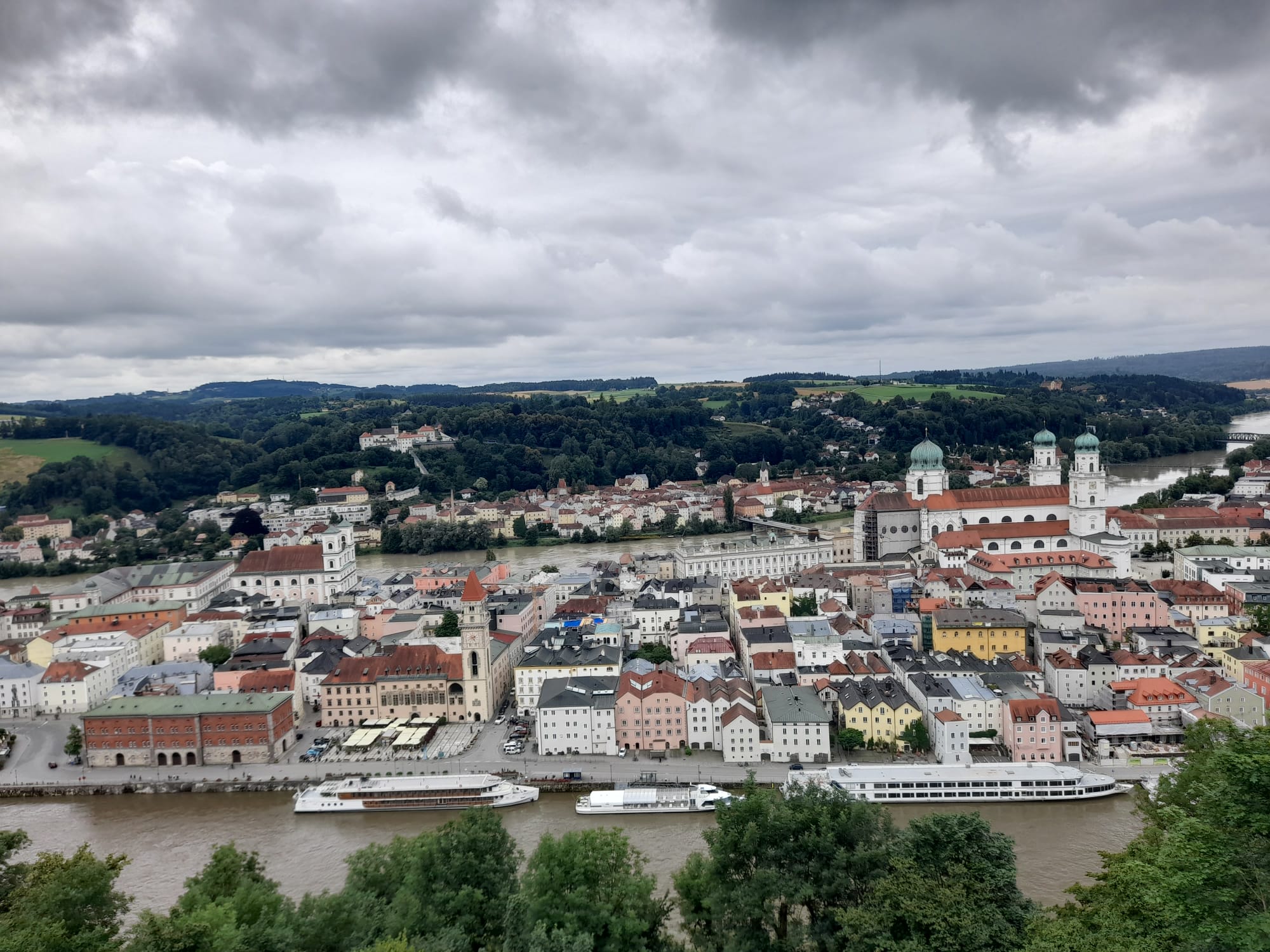
source: own photo.
Tickets to Passau cost 15.6 euros one way, or you can use the “South Bayern ticket” (Südostbayernticket) if you want to go and come back on the same day, for just 22 euros per person, and 8 euros for each extra person. So, if you´re planning for a short trip with your roomies or some friends (always remember the latest SARS-COVID-19 regulations, as stated by the federal and national government), this might be a great opportunity!
Remember the ticket can be used between 9 am and 3 am of the following day from Monday to Friday and all day during Saturday and Sundays. Great news too: children travel for free!
Top 5 things to do in Passau
Walk the “artist alley”
Passau is known for its beautiful small art galleries, which are all alongside Höllgasse street. You can easily identify this street because of its pavement with multi-colored stones.
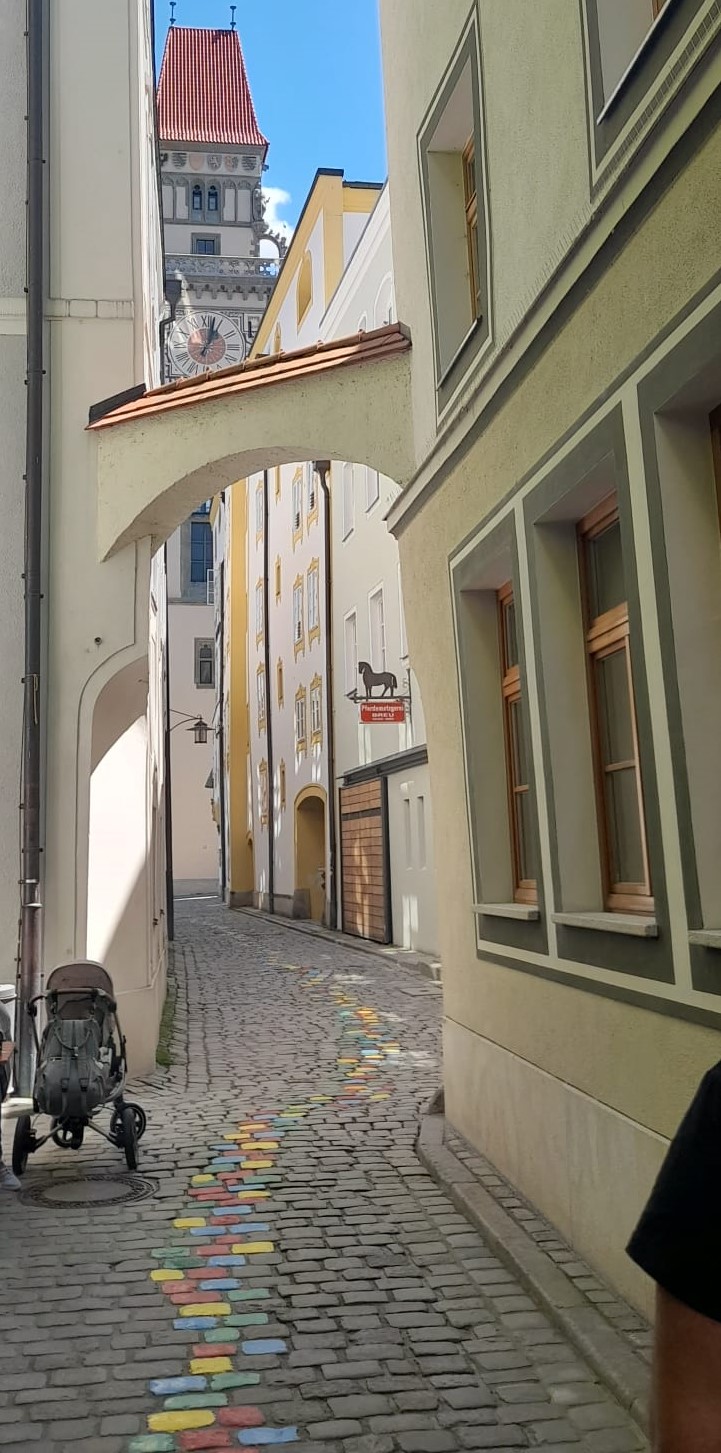
Visit the St Stephans cathedral
St. Stephens cathedral and the buildings attached to it will give you an amazing image of the city´s past and its present. Alongside it, you have one of my personal favorite cafes: Café Anton; and one of the city’s oldest libraries! A total adventure
for book lovers!Walk alongside the Inn or the Danube, until the three rivers joint point.
Ahh one of the most loved and dreadful places for Passau residents, as it provides a beautiful and unique view of the city and its connection to its rivers, but it can be easily flooded during rainy days, the "Dreiflüsseeck " provides an amazing view and nice relaxing area after walking around the city.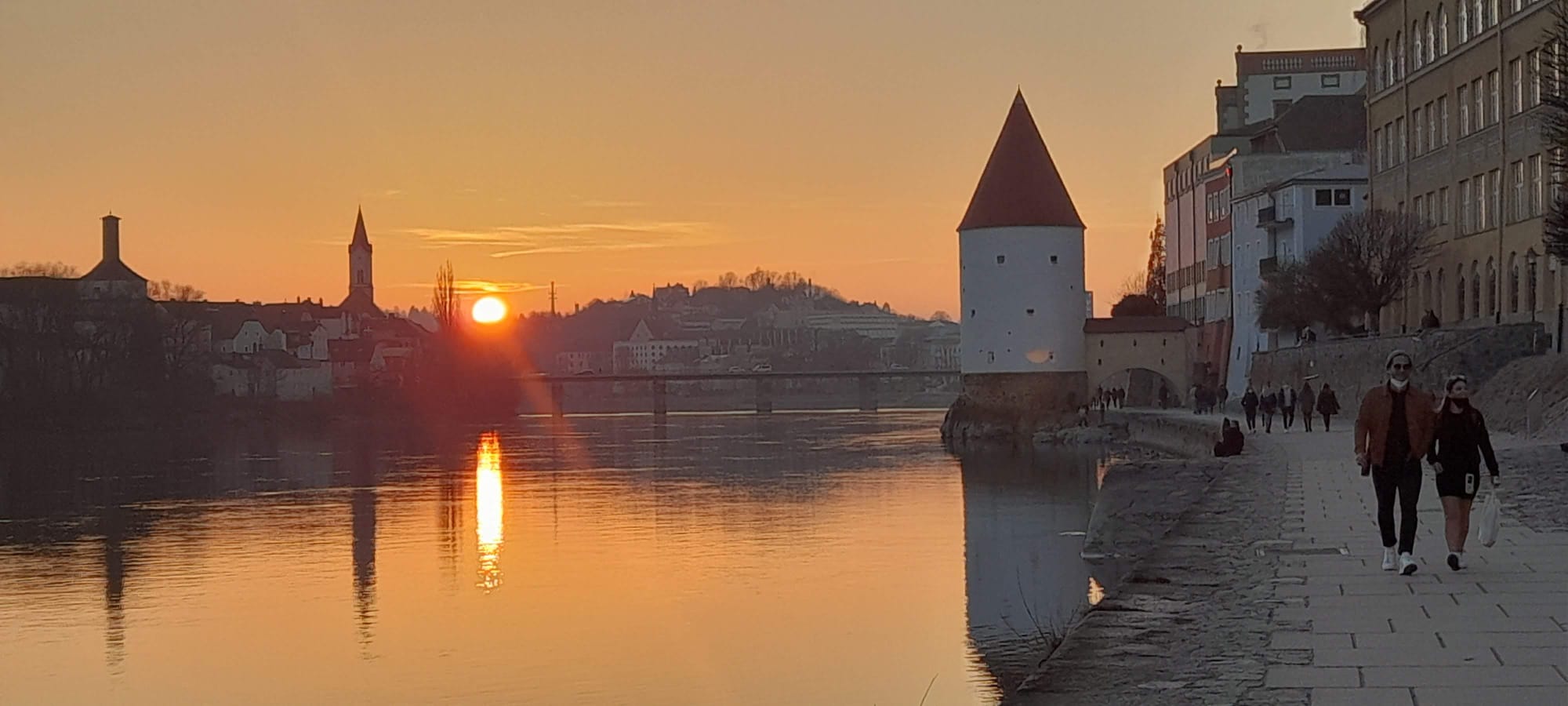
Get one of the best views from the Veste Oberhaus viewing point…
… and maybe stop for a pint of Bavarian beer? Veste Oberhaus is an old fortress and monastery, which served as a stronghold for the bishops of Passau. From there you can get amazing, beautiful views as almost nowhere else in Passau. Next to it its also
one of Passau most well-known restaurant, Veste Oberhaus Restaurant, where you can enjoy a refreshing beer with a unique view. You can get there walking from the left side of the Danube. It´s not a very difficult way up, but if you have any preconditions and especially if it´s during a hot day you should bring plenty of water, something to cover your head and do any necessary stops.
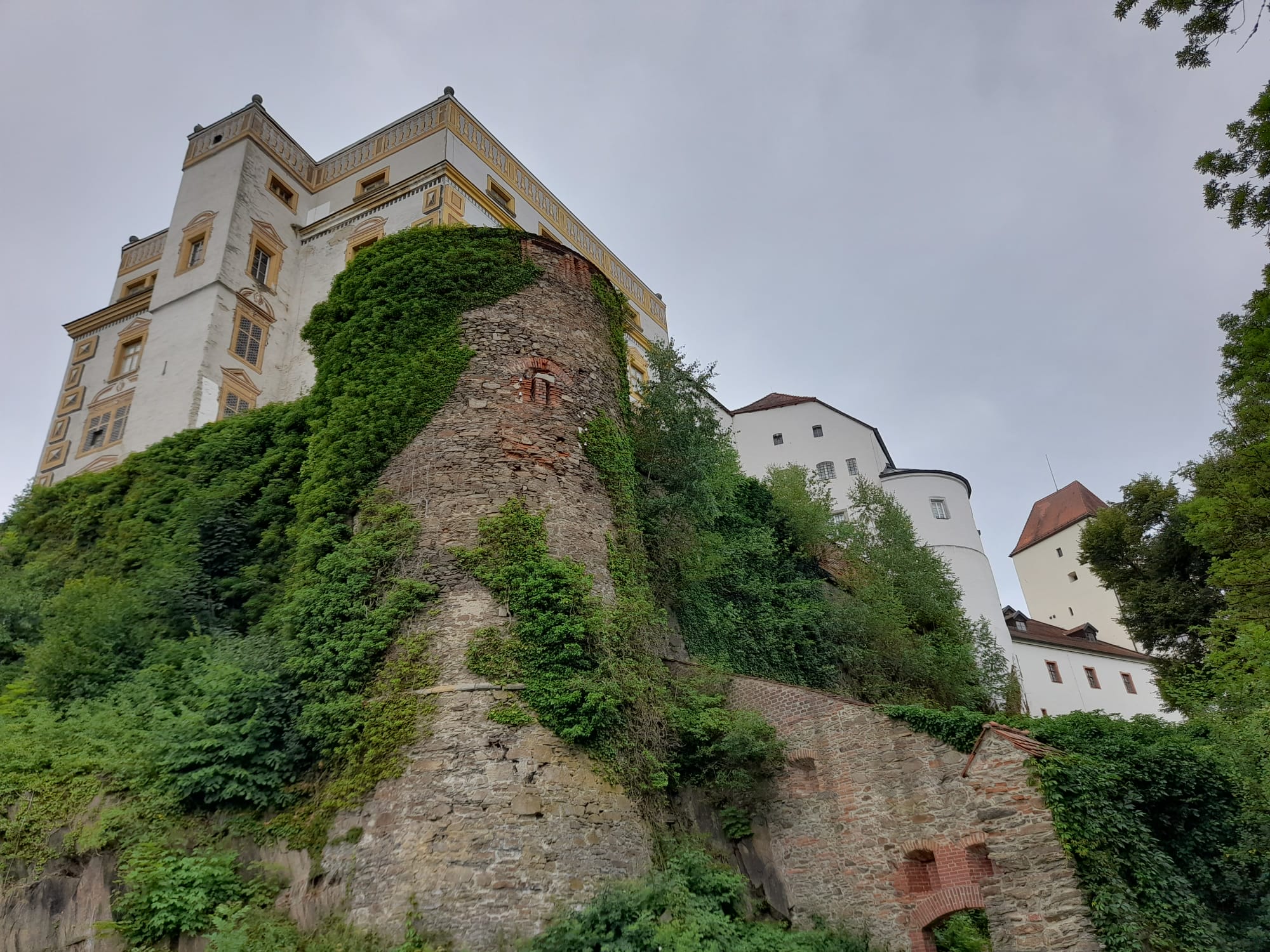
Visit the city center, from the main railway station until the Inn River – and even further beyond!
Passau has amazing architecture and a very lively city center which will always offer you something. Getting out of the Railway station, you can walk straight until you reach the Europa passage shopping mall, and then go left towards Passau pedestrian street. There you´ll find nice little shops, cute cafes, and traditional restaurants to enjoy the best of Passau on a budget.
Don´t be afraid to explore the city by entering some of the smaller streets and alleys.
Where to eat in Passau
(Disclaimer: we take no responsibility for the restaurants and gastronomic venues here mentioned. There is no commercial or promotional relation between the following gastronomic venues and ECRI, THD, ECRI News, or any member of the ECRI News Team).
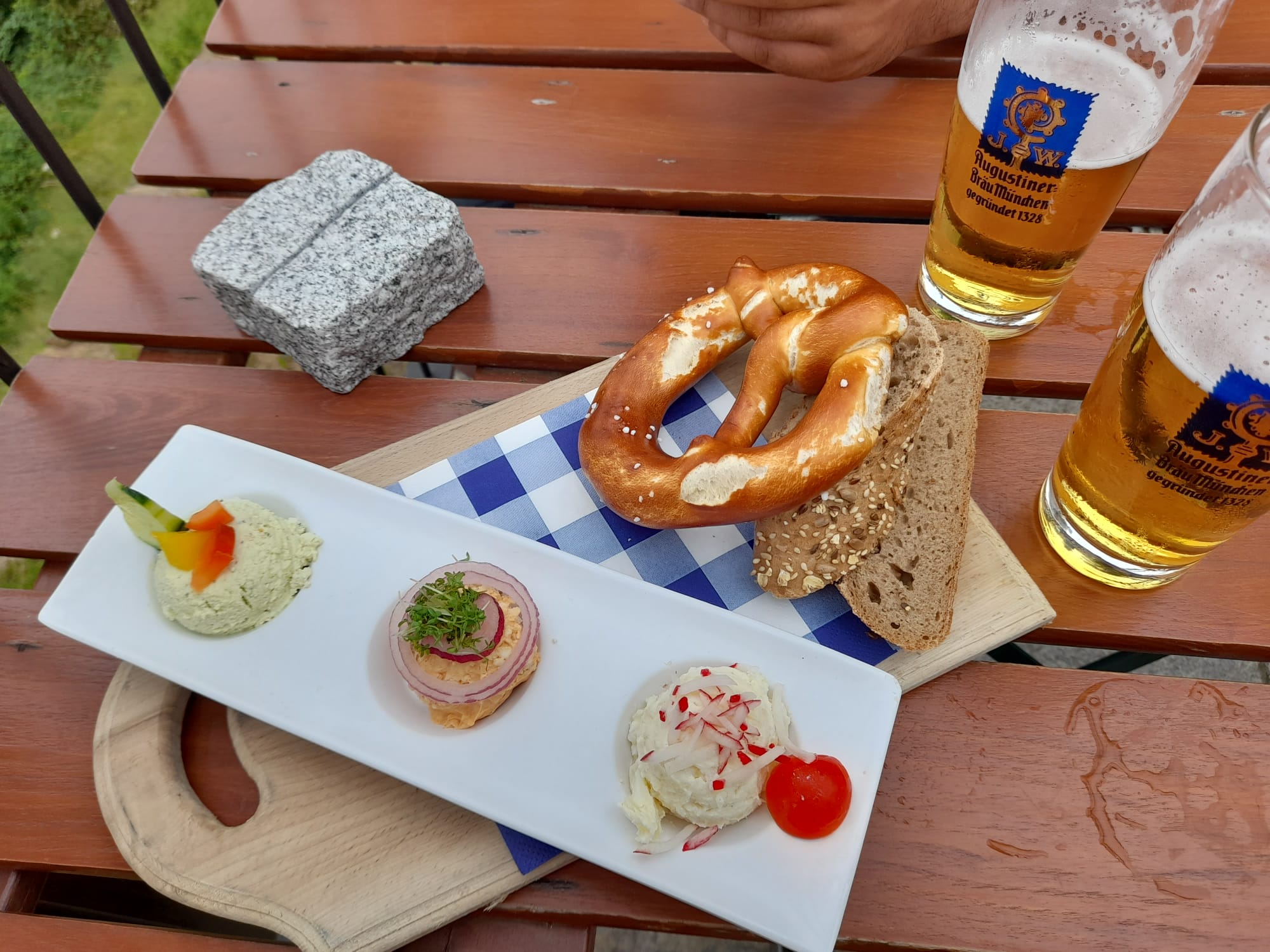
Pointing out towards good restaurants is always a hard task, as this is a very personal choice which might be influenced by your own personal taste, but there are some landmark places which can be pointed out in Passau, be it by their historical connection to the city, views, and architecture, or just their great, tasty food!
For those who want traditional food
For those who want traditional Bavarian food to go with this incredible environment and landscape, several options are available. The Löwen Brauhaus Passau, just in front of the municipality (Rathaus) offers traditional food in an incredible place, and with a beautiful outside terrace. Das Oberhaus, already mentioned before, offers the same type of food in another unique location of the city. Hotel Restaurant Paulsbogen gives a twist to Bavarian food, and it incorporates many delicious and economic vegan and vegetarian options. And if what you are looking for is a nice Biergarten close to the train station on the way back home, then Bayerische Löwe should be your place to go!
For a more detailed list of the best traditional Bavarian restaurants in Passau, you can go visit the recommendations listed in Tripadvisor.
Lunch on a budget
We´ve all been there: being a student doesn´t provide much time for full-time working, and studies must always come first. If you want to have a nice lunch without breaking the piggy bank, Dito´s Gustoria can be an excellent place to visit. Located in a quiet little street just three blocks away from the pedestrian street, where you can enjoy some simple Italian specialties, with prices as low as 5 to 9 euros. The service is great, and the environment and decoration will make you feel just as being in Italy.
For a quick bite, Café Emotions and Café San Paolo will offer you sandwiches, snacks, and drinks for a low price in the city center of Passau. Or, if on the other side, you are very hungry but low in cash, Jento Restaurant & Bar has a variety of Vietnamese and Japanese specialties for prices as low as 5 euros!
If you want to explore other budget options in Passau, check here.
A café with a unique view
When in Passau, a place you cannot miss is Diwan Café & Lounge, a unique and great rooftop café just in front of the bus central station, which will provide you an incredible areal view of Passau.
Prices are relatively low, and they specialize in chocolates and confectionaries, so you can expect a great variety of cakes and sweet treats there.
For other venues in Passau, visit this list made by Tripadvisor with the best cafes in Passau.
BeTrifty Event
And, for those who enjoy shopping but want a different experience: what about doing some thrift shopping? During today (3rd of September) and tomorrow (4th) one of Germany´s biggest thrift stores, BeThrifty, is coming back to Passau to offer their unique thrifting experience.
For only 39 euros, you can buy up to one kilogram of clothes. What can be included in that kilo? Everything! But so you have an idea, you can end up buying a whole outfit for just that price, all while buying exclusive brands and helping save water and resources from the planet! What a nice thing, right?
For more info about BeThrifty even, go to: https://bethrifty.store/ or in the online facebook event
(Disclaimer: ECRI and ECRI News takes no responsibility for the information and changes on the BeThrifty event in Passau, or the event itself. There is no commercial or promotional relation between BeTrifty and ECRI, THD, ECRI News, or any individual member of the ECRI News Team).
Passau´s Flohmarkt
If maybe thrifting and finding hidden treasures are your thing, but you can´t attend the event mention before, we can always recommend you the Flohmarkt in Passau, which takes place every Saturday in the Innpromenade, the Inn´s river coastline
street, from 8 until 17 hs.
There you will find tons of different articles, from second-hand furniture, books, electro domestics, and clothes; to new articles sold by local artists.
If you want to know more, visit https://flohmarkt-passau-innpromenade.de/
, where you will find the latest information regarding timetables, dates, and rules.
For more information about Passau (such as accommodation or its ever-changing cultural offer) visit: https://tourismus.passau.de/
For information on transportation around the city, you can visit: https://www.passau.de/LebeninPassau/MobilinPassau/mitBahn,BusundTaxi/Bus.aspx
Short weekend break: Spa Day at Bad Birnbach!
And now, the time has come. Between exams and the end of the semester, most of us planning holidays and/or travelling back home, life can seem very stressful at the moment.
So, if this weekend you want to relax a bit from exams and pressures, we recommend you one of Rottal-Inn´s most beloved locations: The Rottal Terme in Bad Birnbach.
And even if you are cram with exams, studying in front of a pool with the sun shining over you seems better than staying inside the house, doesn´t it?
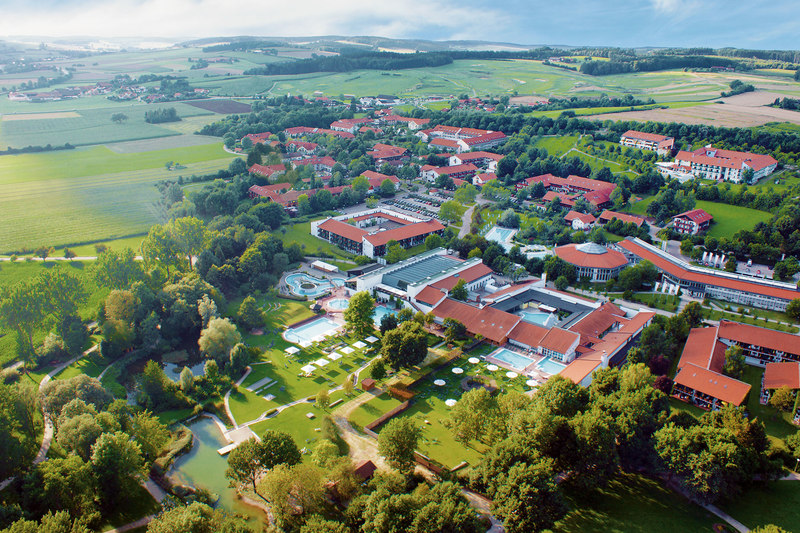
Copyright: Dieter Demuth / gem.AGB
Bad Birnbach is a small Bavarian town, with just around 5 thousand inhabitants. Its is well known for their spa hotels, and their Spring and thermal waters.
Located just 13 km from Pfarrkirchen, you can get to Bad Birnbach in 15 minutes by car, approximately 23 by train, or for our more experienced bikers, in 45 minutes by bike.
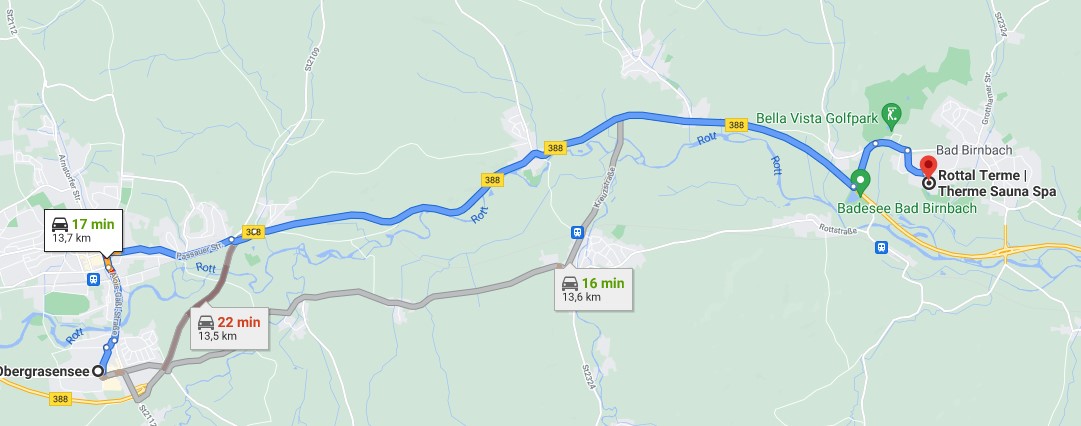
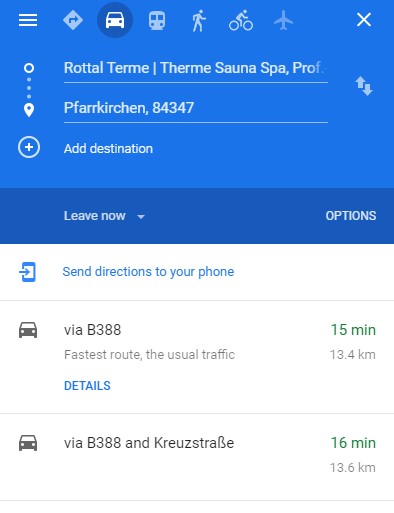




The Rottal Terme has everything you need to enjoy a perfect afternoon. Restaurants with delicious and traditional food; green areas to relax, and three different thermal areas: the Therapeutic Spa treatment, the Spa Word, and the Sauna Word; all of them with their unique pools and centres.
It is opened from Monday to Sunday, 9:00 – 21:00 Hs (Therapeutic Spa Treatment closes at 18 Hs). Prices vary from 12.5 Euros for three hours at the Spa & Spa Word, 17.5 for also three hours, but covering all three areas: or 23.5 euros for a day ticket.
There´s also the option to pay for extra sport classes at the Terme, beauty and skin-care treatments, or special promotions for bigger groups.
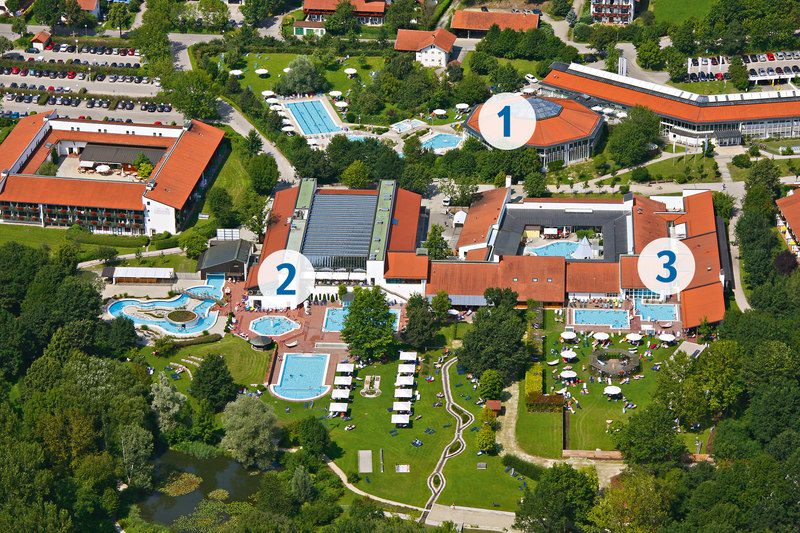
Copyright: Abel Reiner / gem.ABG
And if you want to explore more around Bad Birnbach, you can also visit the city centre, where you´ll find a new and innovative surprise: Bad Birnbach has now a small autonomous bus! This cute and small bus will take you from the train station to the market square.

Coyright: Eva Stranzinger / dem.AGB
For more
information about the Rottal Terme visit:https://www.badbirnbach.de/rottal-terme/rottal-terme-im-ueberblick
And about the city: https://www.badbirnbach.de/
If you want something more local, don´t forget our other posts on what to know about Pfarrkirchen, places to exercise in Pfarrkirchen, and many others!Best TV Shows and Movies to learn German!
Learning a language through movies, tv shows and music, is one of the best ways to start assimilating new vocabulary and pronunciation. Also, it allows you to understand real conversations, expanding your listening skills.
Here we have selected some of the best, all time movies and tv shows, so you can learn German in a fun an easy way, chilling on your bed or your couch, and with a popcorn by your side! There a wide variety for every genre preference, length duration and on a lot of different platforms, so you can choose the one that best suits your situation and likes!
And be aware, because we will constantly add new movies / tv show to the list!
DARK
Genre: Science fiction, suspense
Seasons: 3
Episodes
: 26
For: 16+
Watch on
: Netflix
After the sudden disappearance of two children in the fictitious small town of Winden, four families will seek the truth, unraveling a complicated and sinister time travel conspiracy, which goes back to several generations before them.
The series explore the nature and relationship between the families in Winden, all connected between themselves, and which will see their darkest secrets reveled before themselves; while at the same time explores the reason for human existence and the meaning of time and space.
Dark is a science fiction and drama television series. It run for three seasons, and it was the first German-based Netflix produced series. It has been praised for its storyline, visual, effects, and the complexity of the narrative.
The level of German here is a bit complex, we recommend you turn on the German subtitles for better understanding.
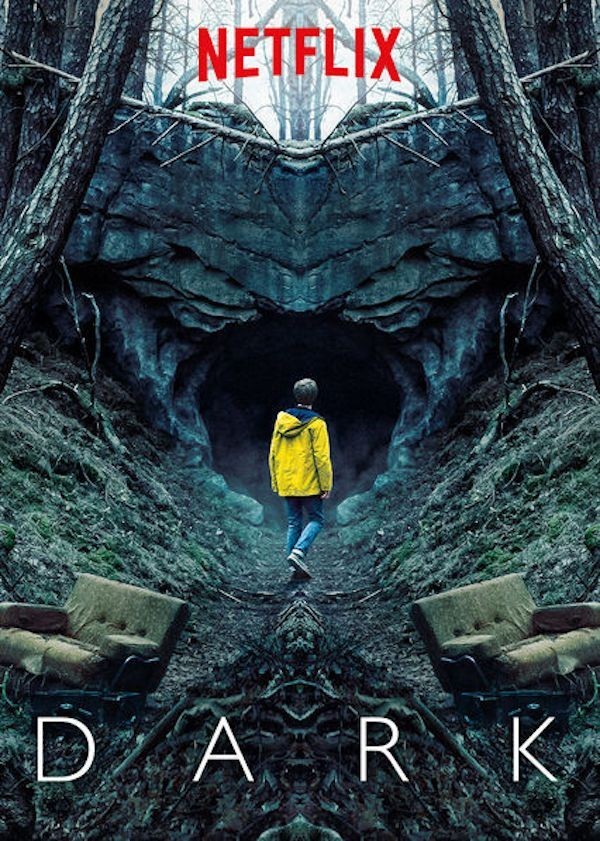
Bild: IMDb.com
Babylon Berlin
Genre: historical crime
Seasons: 3
Episodes: 28
Watch
on
: ARD, Sky Deutschland, Amazon Prime Video (by payment)
This mega-series, based on the books written by Volker Kutscher (“Der nasse Fisch”) is set on the late 20s and early 30s Weimar’s Republic, a time for big social and political changes. During the first and second seasons, the series narrate the story of Gereon Rath, a Cologne police inspector that is transferred to the Berlin department, where he leads an investigation on the growing pornography network, with the background of the social and political changes of those times, nightlife and cabarets. Berlin is shown as a city full of light and liberty, something that starts radically changing with the arrival of the national socialism.
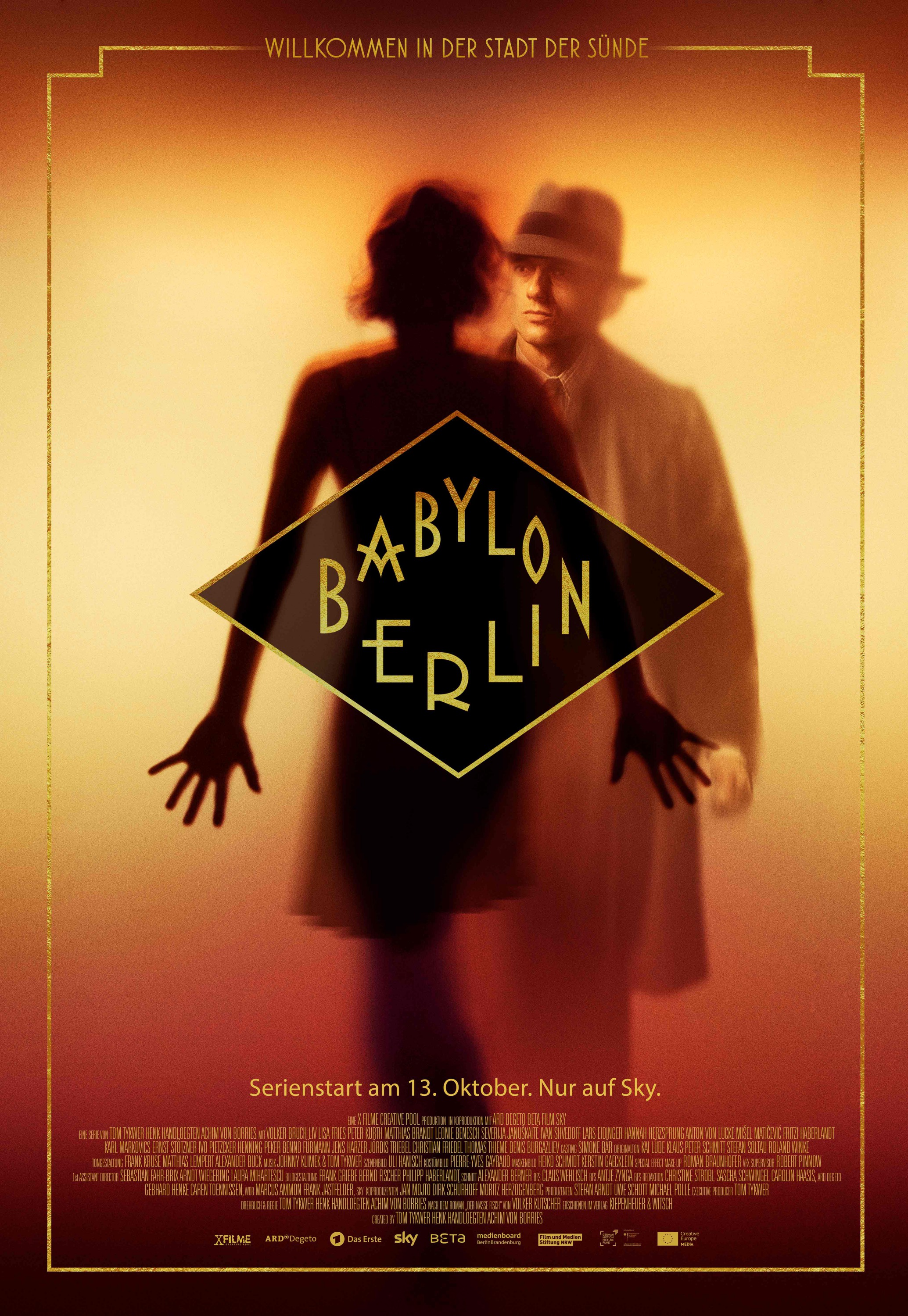
Bild: IMDb.com
Deutschland 83
Genre: Cold war espionage, suspense
Seasons
: 1 (first part of a trilogy)
Episodes: 8
Watch on
: Amazon Prime Video
On this German American trilogy, 24-years-old Jonas Nay is sent from East-Germany into West-Germany, as an undercovered spy for the HVA, the Stasi's foreign intelligence agency. Deutschland 83 is followed by Deutschland 86, set three years after the original series; and there is a last part, Deutschland 89, the year of the fall of the Berlin Wall.
Regarding the German level, Deutschland 83 is spoken in a very clear German. However, there are some scenes where they speak on difficult terms or very fast, so turning on the German subtitles could make the whole process easier for you.
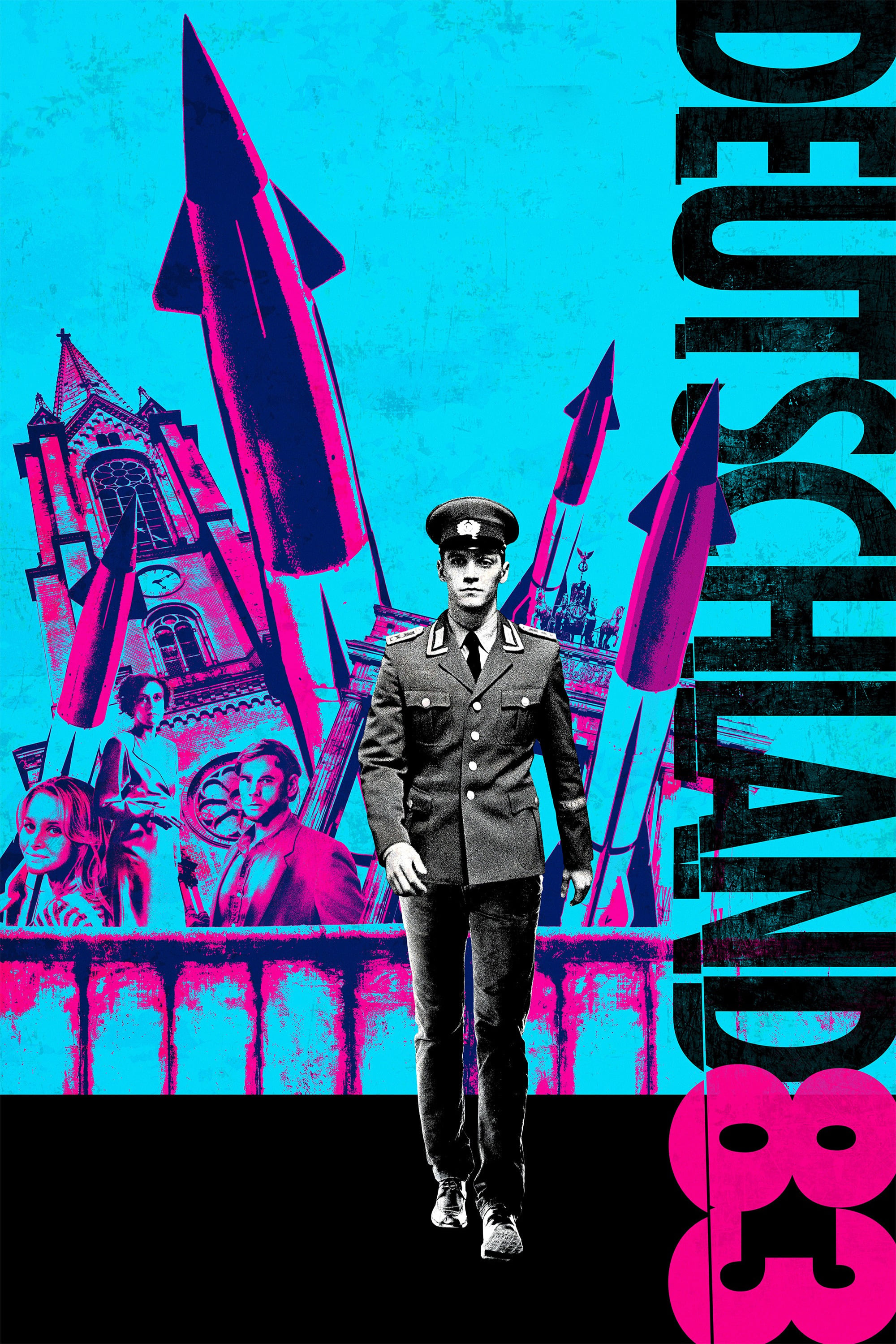
Bild: IMDb.com
Das Leben der Anderen
Genre: drama, thriller
Year: 2006
Duration
: 137 minutes
Watch on: Netflix
In 1983 East-Berlin, secret-police agent Gerd Wiesler conducts surveillance over the well-known writer Georg Dreyman and his girlfriend, actress Christa-Maria Sieland. Wiesler becomes increasingly absorbed by the writer’s life and the world of the art, to which he had been so far from.
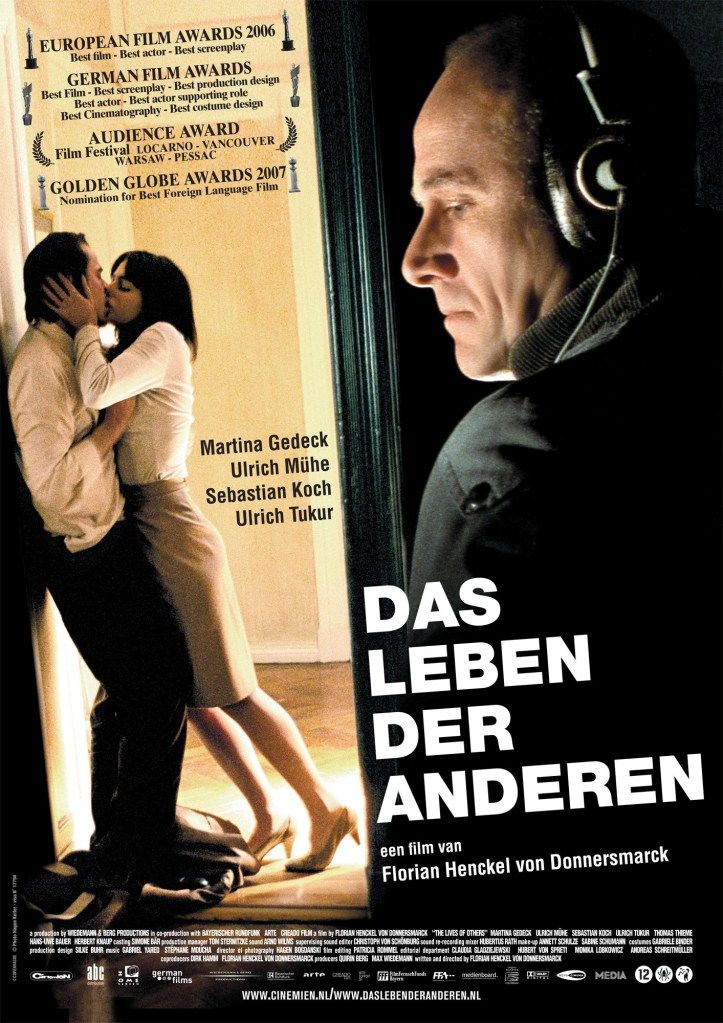
Bild: IMDb.com
Almanya
Genre: comedy
Year: 2011
Duration
: 101 minutes
Watch on: Netflix
After living in Germany for 40 years, the patriarch of a multicultural family announces they are returning to Turkey, their ancestral homeland, to repair a summer house he bought there.
The movie directed Yasemin Şamdereli, a Turkish descendent herself, explores the idea of identity and sense of belonging of the old Turkish work immigrants and their descendants. It had more than 1.5 million viewers and was number 4 when it was released, in 2011.
It is spoken in a very easy and practical german level, great for all learning levels.
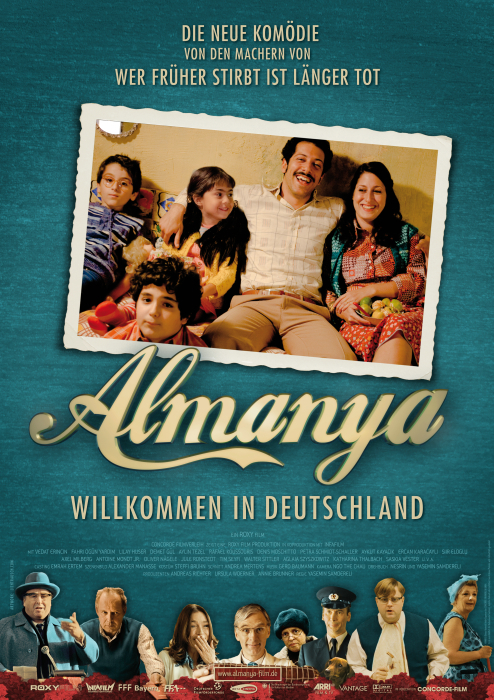
Bild: IMDb.com
Ayelen Toscano Juanes • 02/2021
Best German podcasts for all-levels learners!
Learning German doesn’t have to be difficult! With these podcasts, available in various platforms, you will find that learning Goethe’s language can be as easy as any other.
Beginners
1-Learn german by Podcast.
Great podcast for people already living in Germany! This one doesn’t concentrate on basic worlds, but rather simple conversations.
Available in: iTunes or website
2-Coffee Break German.
This podcast is designed as an easy-to-understand, quick lesson; which will help you advance through different levels.
Especially good for people with little to no time, Coffee Break can be – literally – listened to during your coffee breaks at work/between classes. The shortest ones (6 to 20 minutes) are beginner’s level, and the longest ones,
a bit more advanced. We recommend you listen them from the oldest to the newest podcast, especially if you are a total beginner.
Available in: Spotify
3-Slow German mit Annik Rubens.
If you want to improve your knowledge on specific areas, Slow German from Annik Rubens is a podcast you must listen to.
From topics such as “Food & Drink” to “Sustainability and climate change”, you will surely find one you like.
Available in: Spotify
4-Warum nicht?
I mean, if you here that the Deutsche Welle and Goethe Institute joined forces and developed a podcast for upper-beginners/low-intermediate learners, you know it’s gonna be good.
This podcast, design to help you advance from A0 toB1, will take you along the journey of their fictional journalism student,
Andreas, as you go from one level to the other in the four-part series.
Their podcast can also be complemented with grammar exercises, translations, vocabulary list, among other things.
Basically, a lesson on itself more than a podcast.
Intermediate
1-Wieso nicht?
These series, which are the continuation of the warum nicht? Series is great for more experienced speakers. Once more, we accompany Andreas on his journey and learn new grammar and vocabulary on the way. Link
2-The Easy German.
If you want longer, deeper podcasts, easy German is the one for you.
They are about thirty/ forty minutes long, with very different topics (from philosophical topics to leisure travel and tourism), they could be considered the longer, more advanced, counterpart of the “Slow German” podcast.
Available in: iTunes, webpage
3-A flavour of German.
From the Coffee Break creators, a flavour of German offers that same, relaxed style, but this time focusing on idioms and common phrases. Episodes are 5-8 min long, very practical for people with no time.
Find them in: iTunes or online
4-News in Slow German.
Well, the name says everything. In this podcast you will find current events, talked slowly and at the same time picking on grammar and vocabulary topics to explain them better.
You can find them in iTunes, online or Spotify.
Advanced
1-Elementarfragen.
If what you are looking for is a challenge, you have found it.
This podcast, basically designed for native speakers rather than students in mind, is a very complex podcast which takes about biographies of “exceptional” or important people, such as musicians, doctors… or even bank robbers
and police officers.
Each episode is between one and two hours long, and you can find it in iTunes and Spotify.
2-Deutsch mit Schmidt.
These very interesting podcasts have a total different approach from other ones: while other podcasts concentrate on grammar or wide vocabulary lists, Deutsch mit Schmidt concentrates on only one or two new words per episode, really making
the best use out of them.
Aimed at upper-intermediate and advanced learners, this 8-minutes-podcast is very convenient for advanced learners with little time on their hands.
Available in: Spotify, iTunes or here.
3-The German Podcast.
Aimed at advanced (B2/C1) German learners, this podcast picks one modern-day cultural topic per episode (such as, rock music, tv-shows, video games, etc) which is presented by the host.
You can find it in iTunes and Spotify.
4-Marktplatz.
If your approach is more “professional”, or you would like to quickly learn german for business rather than daily life, we recommend you Deutsche Welle’s Marktplatz podcast.
Is set for a B2 level, and it will help you with business-related terms and topics.
Sources for this article:
https://www.rypeapp.com/blog/these-12-podcasts-will-help-you-master-german-in-no-time
https://www.babbel.com/en/magazine/german-podcasts/
https://www.ef.com/wwen/blog/language/learn-german-free-podcasts/
https://liveworkgermany.com/learn-german-podcasts
Ayelen Toscano Juanes • 23.04.2021
Travelling by train through Europe? Best tips to make your journey a great experience
With the app OMIO you can quickly find out whether the journey is cheapest or fastest by train, bus or plane. We recommend the train of course!
Looking for your next train journey in Europe?
Here are a few ideas:
Glacier Express. Switzerland.
St. Moritz - Zermatt. daily. 290 km. 8h.
On the route: 291 bridges, 91 tunnels, panoramic windows, alpine idyll, forest, waterfalls, mountains.
Bernina Express. Switzerland.
Chur - Tirano. daily. 156 km. 4,5 h.
On the route: 196 bridges, 55 tunnels, panoramic windows, lakes, waterfalls, gorges, one section of the line is a Unesco World Heritage Site: RhB Albula Line.
Brennerbahn. Germany - Austria - Italy.
Munich - Venice. daily. 563 km. 6,5 h.
On the route: There are certainly more beautiful routes to discover the Alps by train, but the route connects 3 countries and the connection is very good. From Bozen there are good and cheap train connections to discover South Tyrol.
Ayelen Toscano Juanes • 11.02.2022
Hiking tour organized by the DAV
The DAV (German Alpine Club), an institution that, as its motto says “loves the mountains, protects the nature”, by organizing different trekking, tours, excursions, alpine hut visits, and many other activities, in nature and climate-friendly
way, is organizing exciting and interesting trekking in the mountains, leaving from Pfarrkirchen, and accessible for all students!
Do you want to know more? Below you will find all the information you need, or you can also get in touch with the contact person listed in their flyer!
For more info about the DAV (In German), please visit: https://www.alpenverein.de/
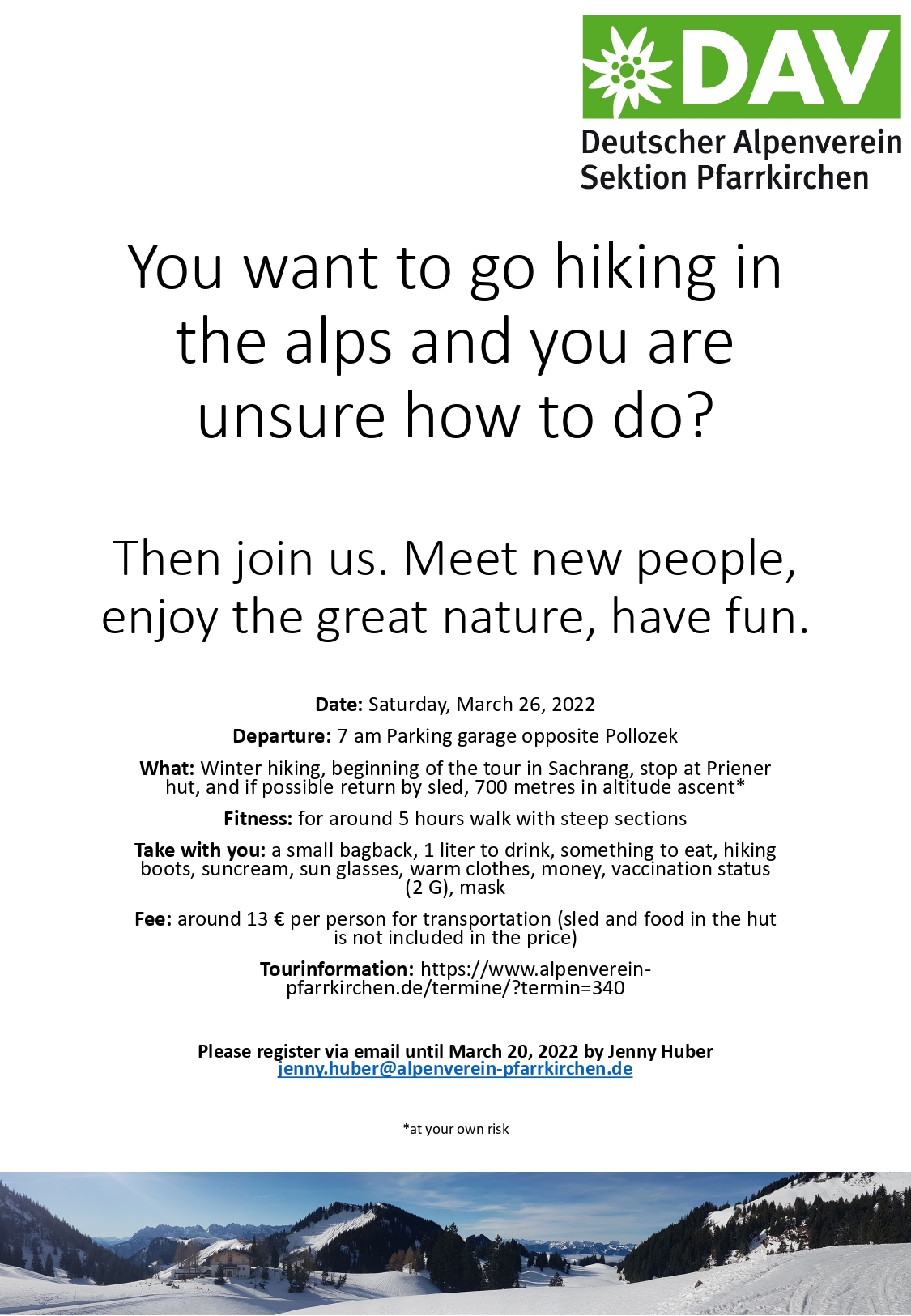
Contact email: jenny.huber@alpenverein-pfarrkirchen.de
Ayelen Toscano Juanes 11.03.2022
Christmas in January?: A tale of Orthodox Christmas told by Maiia
Christmas
is a very special time of the year for everyone who celebrates it. Family
gathering, a lot of cooking and eating, chatting with relatives, and much more.
Although a lot of us celebrate Christmas day on the 25th of
December, opening gifts and eating traditional Christmas cookies, many other
people celebrate it on a different day and with different traditions.
Today we talked with Maiia Osipova, an exchange student at ECRI from one of our
partner universities in Russia, who celebrates Orthodox Christmas, so she could
tell us more about their traditions and celebrations.
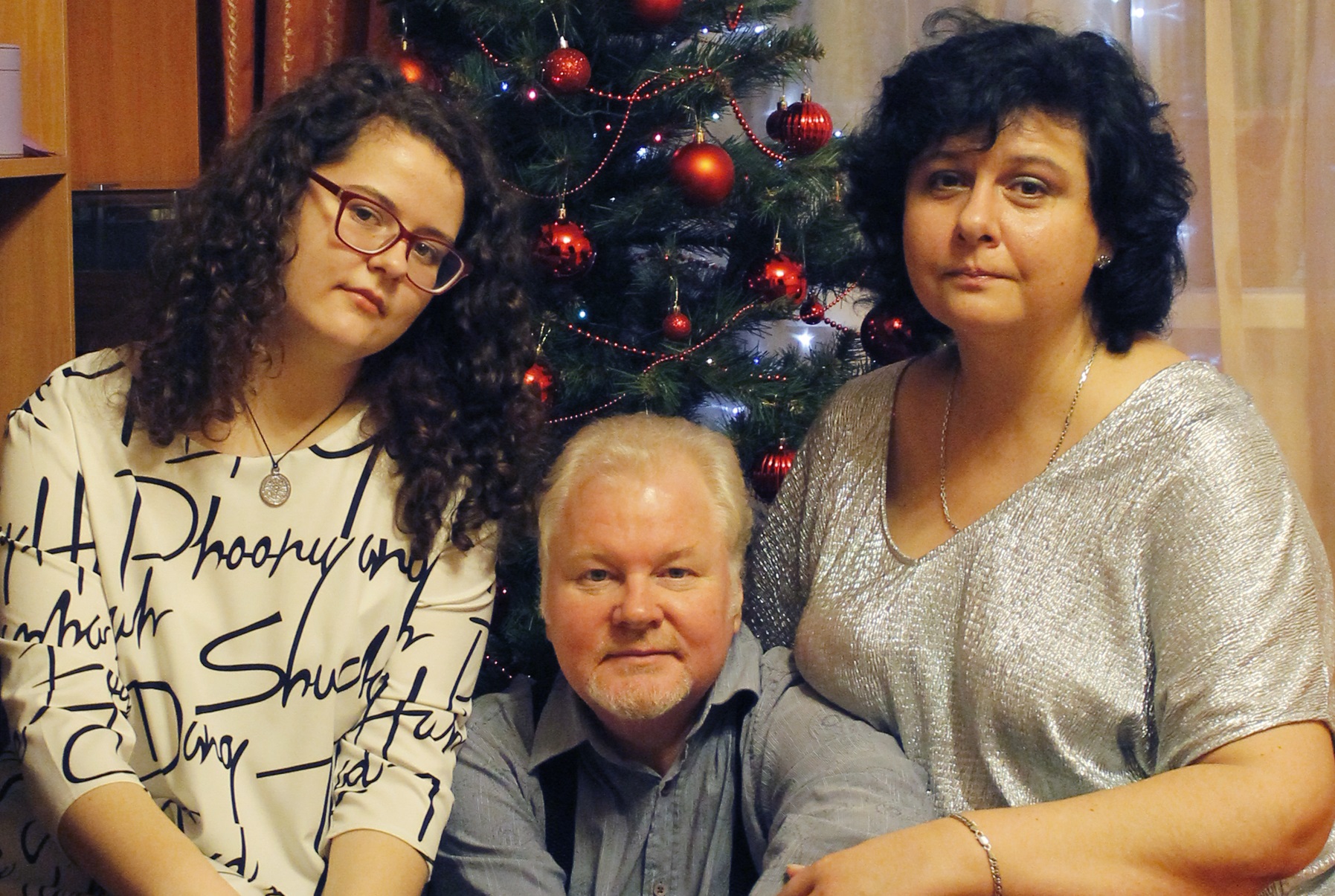
The first thing we asked was, of course, when is Christmas for her!
“Christmas for me is on the 7th of January. In any case, it is
actually the same day, the only thing is that we use the Gregorian calendar,
but for religious things, the Orthodox Christian church uses the Julian
calendar.
And what do you usually do on this day?
So, Christmas is a small intimate thing for us, but the days before Christmas
are not. We celebrate first the new year eve, on the 31st of
December, and that day there is a very big party, gifting presents and much
more.
After that, from the 1st until the 10th of January we
have holidays. Offices, schools, and universities are close. Supermarkets,
restaurants, bars, bowling alleys, and all other entertainment centres are
open.
For the 7th of January, we don´t make such a big thing as they do
here in Germany for Christmas Eve and Christmas Day. For us, Christmas is just
about meeting with family, cooking during that day, dressing up and spending
time with our loved ones.
Do you have any traditional food?
Well, each person has theirs. A very common traditional dish is a kind of pork
meat dish, which is served with the water that is cooked, and it transforms
into a kind of jelly. It is better than it sounds, I swear! My father likes to
cook it sometimes.
And do you have any traditions when it comes to Christmas?
I think that there are some traditions which are still alive in some parts of
Russia, maybe more rural areas like Siberia. But I am from a small city close
to Moscow, and we don´t have many.
I know there used to be two very big traditions that Russians used to
celebrate, even in Moscow.
One was called koledovane in Russian, and it was mainly for young
unmarried men, but also other people participated in it. It consisted of people
gathering themselves and dividing themselves into groups. Each person in the
group had their role, and they were led by one. It was mostly young unmarried
men that participated, but also other people could join.
Then the group would go from house to house, singing songs. They believed this
would help them get food for the next year, and get rid of illnesses.
While the men did this, women normally stayed inside the house. The young
unmarried ones would play games, trying to guess who they would marry. They
would try to sort of “guess their future” using elements, such as looking into
mirrors; or burning a match, which would indicate them into which direction the
future probable husband would be.
It can sound silly nowadays, but in those times being sure that one had enough
food, or who was one going to marry, were very important issues.
The food one was especially important, because Russia is a very big and vast
country, and you can almost feed yourself with everything the earth gives you.
But if they had a bad year, and didn´t have food, it was going to be a very bad
year.
And this was all done on Christmas day?
Yes, always on Christmas day.
What is it that you like the most about this day?
Well… holidays of course! We have all those 10 days off, and I used to love
that as a kid. I didn´t have to go to school, and I could just stay home and
play with my friends.
What was even better, is that my birthday is on the 4th of January,
so I always knew my friends and family would be free those days, and we could
meet and do something fun for my birthday.
But I also like that I could cook with my family, I remember playing snowball
fights and building snowmen in the cold weather.
Yes, I can imagine! And what do you think that this day means to you and your community? What does this day represent?
It´s a
family day. It´s Family. In Russia we don´t go to church so much, I don´t know
anyone who goes to church, so this day is more about family than a religious
thing.
Family is very important.
Ayelen Toscano Juanes • 17.12.2021
How to survive a German winter when you come from the Global South
I come from Argentina, and we don´t know much about Germany in there. Sure, we know the basics, such as what language they speak, where they are and that they like cars and beers, and we know north-European winters are way worse than south American ones, but none of us could have expected how really COLD it was going to be!
So, how does someone who never experienced these harsh winters (or worst, never experienced any winter at all! I feel you, sweet summer child…) survive it? Let´s start.
Ayelen Toscano Juanes • 3.12.2021
University sport, bringing us together!
Healthy body, healthy mind, it goes, and it says, and that is something we take very seriously at ECRI and the THD.
Apart from the usual sports associations around Pfarrkirchen, walking trails, gyms, and different sports parks, the THD offers different alternatives for its students.
University sports in Pfarrkirchen
This semester our university can finally offer some in-person sports again, and we are all so excited about this! From indoor cycle to squash and badminton, you can check all the sport offered in Pfarrkirchen here.Remember that in some cases pre-registration is not required, but the number of participants is limited, and corona rules need to be followed in all cases.
University sports in Deggendorf
Apart from this, this semester the university also has some other sport offers such as indoor football, handball, and yoga, but all of them in Deggendorf. If you happen to have the chance to go there, or you live near the area, this could also be an option for you.Here you can find all information about university sports and the contact person at the university.
Sport in Pfarrkirchen and the region
And if you want to know more about sport and exercise in the city of Pfarrkirchen, don´t forget to read all our old articles on the matter!Autumn is here! Best ideas on what to do during this season (and the last bit of the summer holidays!)
As we approach the end of our recess period, something else has also arrived: Autumn, that great mid-way season that provides activities for both introverts and extroverts: whether is hiking or staying home watching a movie, you can find something to do without being considered “crazy for staying home with this sun” (hello summer, I’m looking at you) or “are you mad? Going out? It´s freezing outside!”.
So today we bring you, our top recommendations on what to do during this new autumn season in Germany – and how to enjoy the best the end of your summer holidays.
1. Visit Germany´s pumpkin patches - or the local market.
If you thought pumpkin patches were only something seen in American movies, you might need to think twice. Pumpkin patches are very common in Germany, especially in Bavaria, during autumn season. Finding one won´t be hard enough!
And until the open, visiting the local weekly market on Fridays, from 9 to 12, in Pfarrkirchen, could provide a great alternative
2. Go for a hike
Autumn is a great season to go hiking, as the climate is not too hot or cold during those months and the foliage provides an incredible and unique picture.
Take this opportunity to discover new places in your city or town, and if you are in Rottal-Inn don´t miss the opportunity to visit our article on the best walking paths in Eggenfelden and Pfarrkirchen.
3. Take a weekend trip with your friends – either by car or the more sustainable trains
Before the chilly winter settles and none of us want to leave our cozy house, going on a weakened trip with your friends during these last months could provide a great last memory of your summer holidays.
If you need ideas and inspirations on where to go, you can check all our articles on day trips around the Rottal-Inn region: Schönau, Bad Birnbach & Passau
4. Organize a wine (or apple juice) and cheese evening meal!
Or pumpkin soup with beer! Autumn provides for all the best opportunities to cook with friends and spend an evening laughing and sharing your summer holidays memories with them!
5. Build a bonfire and do traditional American s´mores
When fire burns memories come alive, some say, and bonfire is a great way to weather with friends and family and share special moments. Grab some blankets and chairs, light a fire (check that you are doing it in a hazard safety area) and get ready to cook some sausages on a stick or prepare some s´mores (check the recipe here).
6. Bake an apple or pumpkin pie
If there would be a number one autumn activity, then baking would be it! Grab all your incredible findings from the weekly market and get ready to bake! Apple pies and pumpkin pies are some of the best things you can bake during this season. Check them!
7. Visit the local thrift market for new cool clothing!
Pfarrkirchen has two small thrift shops, and near PAN you can find some good Flohmarkten (you can check the Passau Flohmarkt) where you can find beautiful used items for this autumn. Cozy sweaters and pullovers, stylish coats, and jackets…everything’s possible if you know where to look!
8. Carve your own pumpkin in expectation of Halloween!
Okay, we know, we know… Halloween is not yet for another month! But practicing your pumpkin carving skills on a rainy afternoon might come in handy!
9. Learn to knit
New season, new hobby? Take this time to learn how to do something new! Knitting, carpentry, baking, cooking, photography… take your pick!
Ayelen Toscano Juanes • 24.09.2021
Eggenfelden: Augmented reality tour for beginners
Continuing with our articles on activities for the summer recess, today we bring you one for those wanting to try something different: an augmented reality tour in Eggenfelden, the first of its kind in Germany!
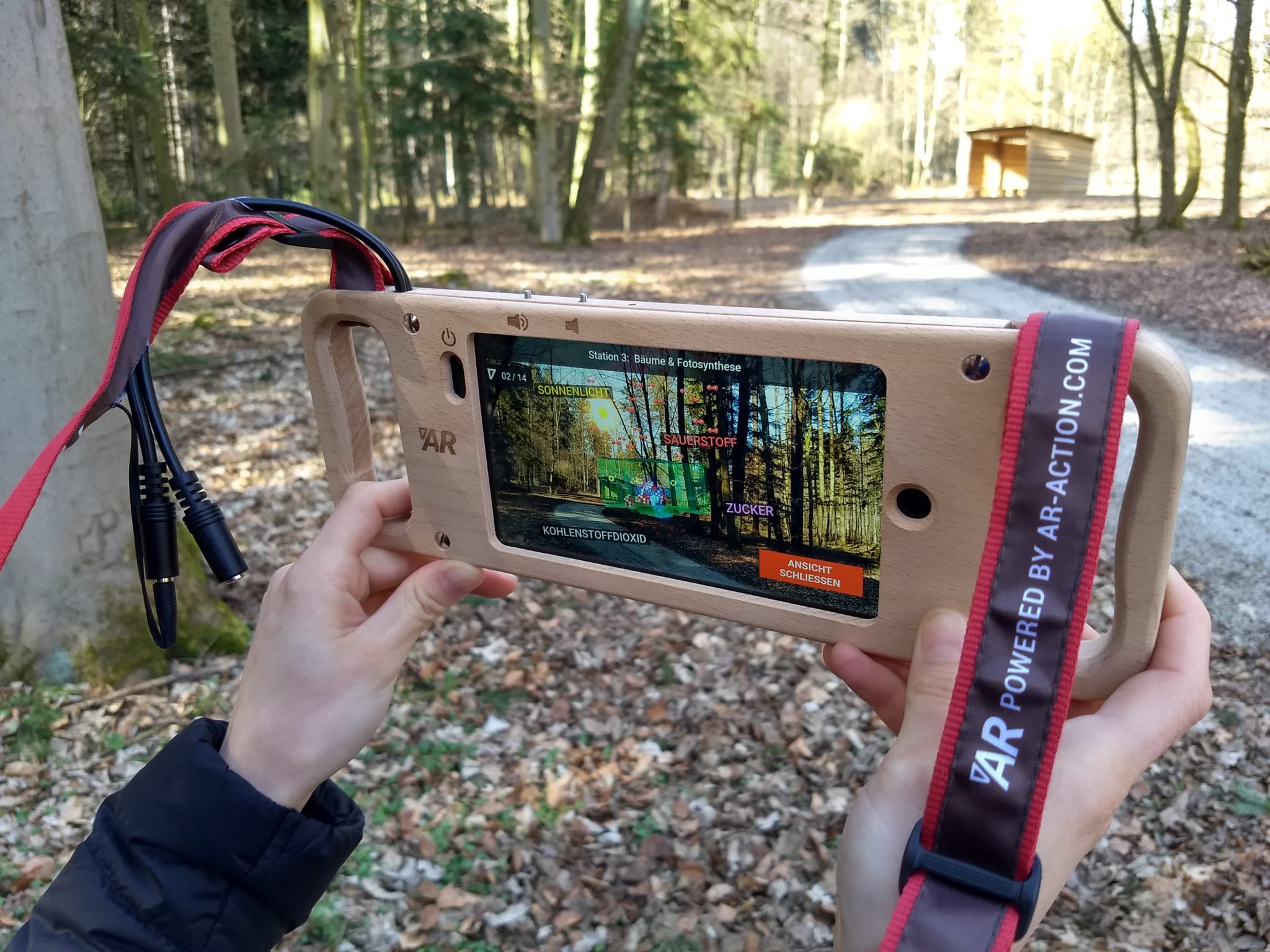
Copyright: Bürgerwald Eggenfelden / Stadt Eggenfelden
This three- hour- tour in the “Bürgerwald” will allow you to explore the forest virtually and physically, at the same time.
The tour is offered every Friday at 14 hs, by meeting with the rest of the people at the main entrance of the Bürgerwald, right on the overview board. There you will meet Artemis, the guide for this tour. But be aware, Artemis is not your regular tour guide: he is a 3D digital interactive fox that will guide you through the site and explain the ecosystem of the place.
The tour takes about 3 hours walking on natural trails and is easy enough for everyone. During these three hours, you will experience the forest like never before, being able to answer all your questions about ecology and sustainability in an interactive, educational and fun way.
This tour is only offered in German, which will provide you with a great opportunity to test your German skills and train them in a different environment before starting classes once again in October!
For this tour you only need to bring your best walking trainers, earplugs and let the experience begin!
For more information you can visit https://buergerwald.eggenfelden.de/ar/ or here.
----
Disclaimer: THD, ECRI, and ECRI News take no responsibility for the content of the external links here provided, not for the Augmented reality tour organized by the Bürgerwald Eggenfelden.
Ayelen Toscano Juanes • 17.09.2021
Best english podcasts
After last week´s successful articles on german learning podcasts, this week we have designed an English-based podcast list, with a range of different topics… From tourism, to business, TV & Film to music… there is a podcast for everyone! And of course, improving our advanced English skills in a fun and easy going way is always a great advantage! .
Talking tourism
This podcast, perfect for tourism students, professionals or just tourism lovers, helps you understand current trends, changes and all the “ins and outs” of the tourism business industry.
Find it online or on Spotify
where you can get a new phone in just a few days.
Ted Talks daily
Who doesn´t already know about the famous “Ted talks”? A brand themselves, now they bring us the latest talks in audio.
From climate change to artificial intelligence and diversity at work; there is a Ted Talk for everybody.
Listen to them on Spotify
Business Wars daily
As any other country, Germany has many different possibilities when it comes to phone contracts and deals. If what you are looking is for an innovative and different podcast to learn about business, then Business Wars is the perfect
podcast for you: Each episode talks about two rival companies, their history and influence – such as Amazon vs Apple. Business wars daily is the shortened version (6 minutes) of the longer “Business Wars”, which are about 30
minutes each. You can find both versions on Spotify: Long version; Short version
The Diversity Gap
“When it comes to diversity, good intentions are only the beginning” so starts the description of this podcast. On it, leaders, authors, creatives, and other influential people, debate on the importance of actions when it comes
to diversity in our society. Very interesting for everybody who is into social change, politics or human rights activism. You can find it here.
The Film Frequency
But maybe what you are looking for is some relaxed, entertaining podcasts. In that case, and if the film & TV industry are your thing, you can´t miss “The Film Frequency”. This podcast covers everything related to the Film
and TV industry, from reviews on the latest tv shows to full debates on classical movies. Find it on Spotify
Sources:
https://player.fm/podcasts/Entertainment
https://www.bluleadz.com/blog/18-of-the-best-business-podcasts-you-should-listen-to-in-2018
https://www.timeout.com/things-to-do/best-podcasts
Ayelen Toscano Juanes • 07.05.2021
App • Google Arts and Culture
I don’t know how you feel, but I would love to see a movie in a cinema or go to a museum without any restrictions. Just like it used to be before corona. Since these activities are not possible at the moment, I stick to the best alternative that is out
there: Google
Arts and Culture.
With Google Arts and Culture you can explore famous sites such as the Palace of Versailles from home, using your smartphone or laptop
This platform offers you a variety of things connected to art and culture, such as artworks, museums, articles about painters or famous pieces, and much more. You can either access it via the website or download the app to always carry your portion of art and culture in your pocket.
Google Arts and Culture has four different categories: games, places, museums and artworks. Each one offers you a broad spectrum of things that are just waiting for you to discover them. The category “Games” comprises
different types of games that are all connected to art and culture. There you will find the Puzzle Party, Visual Crosswords, Art Coloring Books, the “What came first?” and Cultural Crosswords. This is the perfect way to discover
the fun side of art.
With “Places” you can discover over 10.000 famous sites, museums, exhibitions and even stadiums. There you can visit museums using Google Streetview (I would recommend the app for this), but also key sporting locations,
exhibitions that are currently closed or iconic monuments such as the Palace of Versailles or the Taj Mahal. And, you can also take a tour through 10 incredible libraries from around the world or 10 places that inspired your favourite
books and much more.
The category “Museums” takes you inside such sites as the Pergamonmuseum in Berlin and over 2.000 other museums around the globe. That’s the best way to travel the world and discover its art treasures.
In addition to that, the last category “Artworks” lets you take a close look at over 100.000 pieces of artwork. Here you can discover the details you might have missed before. You can zoom into the artwork, or look at the
details of famous pieces and the explanation why these pieces became so famous. You can even zoom into the brushstrokes, which is almost as cool as having a close look at the pieces in a museum.
These are just the main areas
covered by
Google
Arts and Culture. There is much more on this platform and it almost sucks you in as soon as you start your tour there. For me this is the perfect time to spend the weekend in a fun way and still learn a lot about the treasures
out there.
Miriam Bleck • 11/2020
App • MyLife Meditation and Mindfulness App
Sleep better, reduce stress, find relaxation, increase concentration? With the meditation and mindfulness app MyLife (formerly known as Stop, Breathe & Think) this is possible.
MyLife is an award winning meditation and
mindfulness app that helps you find your quiet place.
Try it out:
https://my.life/
Claudia Nikitsin • 11/2020
Film Tip • Interstellar
Interstellar is an epic science fiction movie created by the world-renowned director Christopher Nolan which, according to The Telegraph, has managed to outperform all his previous creations.
Interstellar presents a possible alternative of Earth’s near future, where pollution, global warming and a virus threaten humanity’s existence. These threats are damaging all crops and rendering humanity hopeless in the face
of drought, famine and eventual extinction. Their last hope is traveling through a wormhole placed suspiciously outside of Saturn in order to find some Earth-like planets.
 |
Everyone knows that maybe one of the most important aspect when it comes to movies is the cast. Christopher Nolan had to make sure that he would pick the right actors to play the roles of his main characters. Big names
such as Matthew McConaughey, Anne Hathaway, Jessica Chastain, Casey Affleck and none other than Sir Michael Caine were casted, and managed to perform outstandingly. The 2h 50min long movie tackles some rather complex
questions related to science, morality and the human nature, questions that do not have a straightforward answer, thus making it such a rewatchable movie. The movie was aired on the 7th of November 2014 and managed to earn over $677 million, thus making it the tenth highest-grossing film of 2014. At the 87th Academy Awards, the film won the Academy Award for Best Visual Effects, and was nominated for Best Original Score, Best Sound Mixing, Best Sound Editing and Best Production Design. |
Victor Petcu • 11/2020 |
|
Podcast • Tonspur N
In marketing, the LOHAS (Lifestyle of Health and Sustainability) have already become a own target group. CSR strategies have arrived in the companies, sustainability reports are important means of communication.
The podcast
Tonspur N by Annemarie Harant and Roman Mesicek provides information on sustainable development, corporate social responsibility (CSR) and social entrepreneurship.
What is special about Tonspur N?
The topics range from general knowledge about CSR and sustainability to hot topics, announcements of events and tips for your own everyday life (episode 62: How do we protect our data?).
The podcast is designed as a dialogue. Annemarie Harant and Roman Mesicek are unaffected, honest, entertaining and also self-critical. Their extensive background knowledge even
in some digressions creates a lot of interesting information.
In addition to the 5 series Digitalisation, Consumption, Practice, NPO (Nonprofit Organisation) and SDGs (Sustainable Development Goals), current topics on Corona
or
Responsible Communication are also discussed (episode 42: Kommunikation ist ein Spiegel der Haltung).
Tonspur N - the podcast on sustainable development, corporate social responsibility and social entrepreneurship by Annemarie Harant and Roman Mesicek, is published
every 14 days on Mondays. In each episode they discuss two or three topics, give information on events, book and report reviews and sometimes interview partners can be heard ... unfortunately the podcast is only available in german.
As co-founder of the startup erdbeerwoche, Annemarie Harant faces the daily challenge of implementing sustainable action in her own company. She has more than five years of experience at the management consultancy brainbows in sustainability management with large companies and regularly
puts on the "CSR glasses " in her blog.
Roman Mesicek is head of the Master's programme "Environmental and Sustainability Management " and Sustainability Coordinator at the IMC University of Applied Sciences Krems. He is a shareholder of the business magazine enorm, one of the leading CSR specialists in Austria and co-founder of the Austrian platform CSR Dialogue.
Anna Marquardt • EcoLab • 11/2020
Cyber Monday
With the Cyber Monday the sale in the online shop starts, beside the Black Friday one of the supposed great deals for us consumers! Discounts and special promotions
lure us into the online shops and promise us the best new products and prices. Especially the electronic industry benefits from our often spontaneous purchases in these days.
Do I really need this? We ask ourselves this
question less and less.
But of course, we can't do without electronics either. Today, we would like to give a few tips and information about buying and disposal of electrical appliances.
Every year shops in Europe sell 15 million tonnes of
new electrical appliances. These new devices replace existing ones, so there is a corresponding amount of e-waste in the same period of time.
Around 850,000 tonnes of electrical and electronic waste were collected in Germany
in 2018. 91 % of this comes from private households, the remaining part comes from companies.
But many of these products are not yet scrap and can be used or reprocessed. Used products carry within them the uncertainty of being
in an often unrecognisable condition or soon to be suddenly defective.
Prof Hainthaler has taken the chance and bought a reconditioned smartphone from a certified platform. These devices are not only checked and resold with guarantee but are also between 30 and 70% cheaper than new devices.
In Prof Hainthaler's case, this means not only a €400 saving, a new battery and a 36-month guarantee, but also avoiding 150 g of e-waste.
Markus Hainthaler & Anna Marquardt • 11/2020
Blog articles
Blog article • A practical guide
A practical guide makes life easier.
Here is a practical guide about students you have met or will meet during your student life in Pfarrkirchen and what you can get out of them:
Your friend must be one of those
Hattab Ben-Salah • 11/2020
Blog article • The story of Ha Nguyen
Corona: The global virus has undoubtedly taken its greatest toll on most of the world's citizens. The insecurity brought by this pandemic has proved to be a serious difficulty and challenge for the daily lives of many people.
Amongst those are international students who might find themselves under extreme pressure being far away from home while, at the same time, experiencing a lack of communication.
Read the story of Ha Nguyen, which is about staying healthy and optimistic, both mentally and physically.
Overcome Coronavirus Anxiety Guidance
Ha Nguyen • 12/2020
Pfarrkirchen's "Lange Bank "
Germans often say “Etwas auf die lange Bank schieben“, which is actually a very famous German proverb. If you translate it literally, it means, “To push something on the long bench”. In proper English,
it means to procrastinate or to put something off for a long time. So, the city of Pfarrkirchen definitely showed some humor when they took this proverb literally and created Pfarrkirchen’s “Lange Bank”.
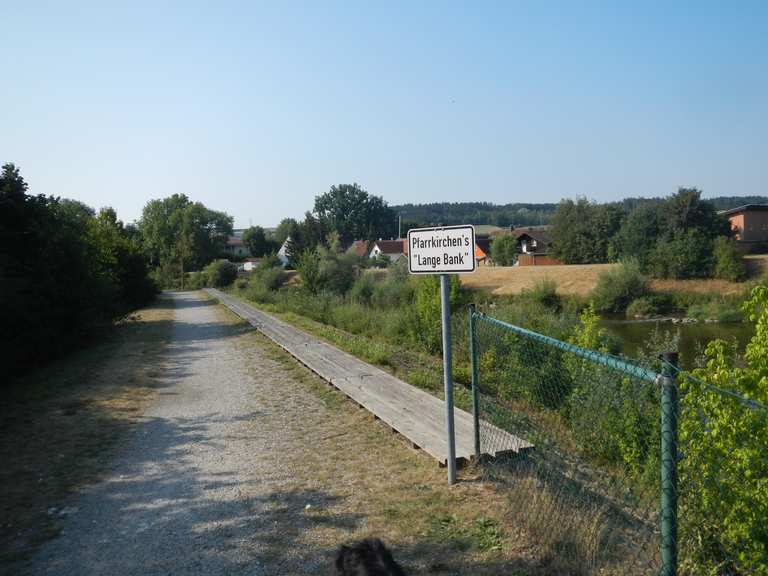
|
It is a very long bench, probably about 10 meters long, that is located at the “Rottauen” along the river Rott that runs through Pfarrkirchen. If you start at the parking lot next to Aldi, walk upriver along the Rott in the direction of the Theatron, and keep walking for like 10 minutes longer, you will reach the longest bench existing in Pfarrkirchen. You will find it along the way, facing the river. This is a really nice spot to just sit, relax, breathe in deeply while the river runs bellow your feet and the sun is shining. For me this place always emits tranquility and makes my spirits go up immediately, which we can all need in these challenging times.
Miriam Bleck • 10/2020 |
|---|
Sport
Best walk paths in Eggenfelden!
So, exams are over, winter holidays are upon us… but you don’t know what to do with your free time?
What about going for a nice walk around one of Rottal-Inn most beautiful cities: Eggenfelden?
If you think having a walk in this cold weather might be complicated, think twice! Walking around with a nice coat and scarf, a coffee or tea in your hand; and then coming back to your warm WG Zimmer or apartment… it
does sound tempting, doesn’t it?
On this occasion, we have prepared three different walking / cycling paths designed for every fit level.
So, let’s get started!
|
Path number one: A walk around Eggenfelden Km: 4 km Difficulty: easy Vertical climb: 30 hm Walking time: 50 min Cycling time: 15 min |
This easy and nice path starts at the “Freibad Eggenfelden” (Swimming pool in Eggenfelden) and goes through a nice round alongside the Mertsee. Then, at approximately the Untereschlbach street (Holzkeller,) you can turn left and start the way back, walking / running along the other side of the Mertsee, with a very nice view of the fields and the river, until you are back at the Straubinger Str. From there, you can continue walking towards Eggenfelden’s center, ending your tour. And finally, why not stopping in one of the small cafes at the historic center an ordering a hot cocoa or a coffee to go, and enjoy it at home? Inspired
by the route provided on: http://www.runmap.net/en/route/216856-ruck-zuck-runde/#/z18/48.4053247,12.751404/terrain |
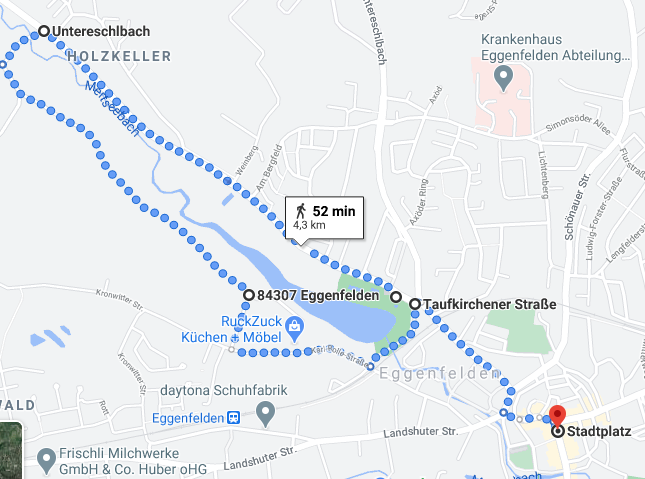 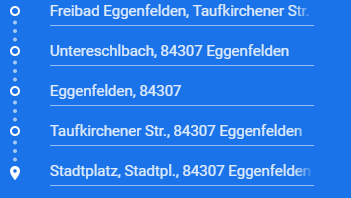
|
|
Path number 2: Get to know Eggenfelden’s whereabouts! Km: 8,2 km Difficulty: easy Vertical climb: 70hm Walking time: 1h 43 min Cycling time: 32 min Suitable for: walking, running, cycling. |
Once again, we can start our walking route from the Eggenfelden Freibad (swimming pool), but this time starting from the other side. Go around the Mertsee, continue on the Karl-Rolle- Strasse, and then alongside the small passage (Weg) behind the lake. We continue on this passage, all until Strasshaeuseln, where we turn right. We go through the little town of Kirchberg, continuing on the Ludwig-Thomas-Strasse, and then start our way back at the Wolfsberg street. We maintain on this street, until we change to the Unterschlbach street. Later we will find ourselves back again at the Eggenfelden Freibad, and we can continue through the Straubinger Street all the way to the center of Eggenfelden. Again, maybe after this much walking you are thirsty, in need of a break… why not stopping for a coffee to go, and then heading back home, to enjoy it? Inspired by the route provided on: http://www.runmap.net/en/route/108961-kirchberg-schwimmbad-drittenbrein/#/z16/48.4076252,12.746222/terrain |
 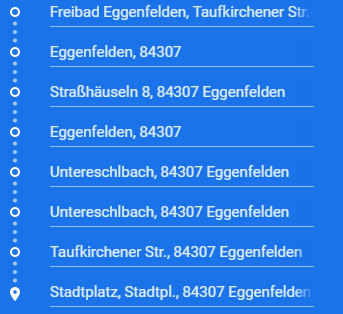 |
|
Path number 3: From Pfarrkirchen to Eggenfelden
(or vice versa) Km: 17 km Difficulty: medium / hard Vertical climbing: 408 mts. Walking time: approx. 3 hs Cycling time: 55 min Suitable for: walking, running, cycling. |
So, finally, our most complex route. Maybe you live in Pfarrkirchen or Eggenfelden…Have you ever thought about a route that connects both towns? Here there is one, which can be done on foot or by bike. It is not difficult, but we do recommend that you take as many stops as necessary. We start on the center of Pfarrkirchen, going towards ECRI Campus. After ECRI, instead of continuing on the main road, we take the small deviation on the right. We keep on that path, and pass through Postmünster center. We continue by surrounding the Rottauensee lake. After that, we proceed on Kirchenweg and Bahnweg, going through the Linden village. We go forward on our journey, passing across the SV Hebersfelden e.V, and across the Rott river once more. On the first corner we turn left, and the again at the “Zur Radlerrast” restaurant. We stay on our way towards Eggenfelden center, and then turn on Gern and Birkenalle street. Finally, we take a turn right on Judengasse street, and we are in the center of Eggenfelden! |

|
Some notes:
To go from Pfarrkirchen to Eggenfelden, you can always take the Regional train at the Pfarrkirchen train station. Trains to Eggenfelden leave every hour, always at half past. It takes 15 min by train, and tickets cost
approx. 4 euros each.
You can always bring your back on the train, for an extra cost.
Remember to wear an FPP2 mask when on the train, bus, or stations.
Remember to always maintain social distance with
people outside your household.
When exercising, especially in winter, remember to drink enough water, wear comfortable shoes for the type of activity you are doing, and wear light but warm equipment. Also, always check the weather forecast before
you leave, and be aware of possible frost on the street (especially when biking)
Most importantly…
HAVE FUN!
Ayelen Toscano Juanes • 02/2021
Take a break from learning for a walk in Pfarrkirchen
Idea for a walk in Pfarrkirchen
The corona
pandemic still has us in its grip. The high number of cases in Rottal-Inn no
longer allows trips to more distant regions. But we can hike wonderfully in and
around Pfarrkirchen. Today I introduce you to hiking trail D.
- Duration: around 2 hour
- Distance: around 7,5 km
- Altitude meters: 99 metres hight
Starting point: Parking lot on “Äußere Simbacher Straße”, very close to the Stadtwerke, in 84347 Pfarrkirchen (see the map at outdooractive).
This tour starts at the Rott, near the Stadtwerke Pfarrkirchen, where the new fitness park is located. On the cycle path along the Rott, we pass the clay pigeon shooting range of Pfarrkirchen and go on in the direction of Netto. Before passing the railway crossing to Netto, we turn right onto the cycle path towards Degernbach.
The hiking trail leads us under the subway to Degernbach. We follow the little river Haberbach and turn left at the end of Degernbach to the main road. We cross the main road. A steep field path leads us back towards Pfarrkirchen, more precisely to Reichenberg. Over the Reichenberg we go through a settlement and a short stretch of forest towards Gartlberg. We pass the new and the old cemetery at the Gartlberg and the Gartlberg pilgrimage church.
The street “Am Paradiesgarten" leads us in the direction of the Landratsamt to the “Ringstraße”. We follow the avenue until we can turn off to “Innere Simbacher Straße”. We cross the railway crossing and are then back on “Äußere Simbacher Straße”, which leads us to the starting point.
Why not hike this tour as a break from learning?
The map and more information to the tour you can find at www.outdooractive.com
Good luck for the exams and stay healthy!
Jennifer Huber • ecolab@th-deg.de • 01/2021
Why not take your bike for a ride today?
You want to
see more from the region you life and study now? Why not explore the region by bike?
At the
website outdooractive.com you can find a lot of nice bike tours in the region
Rottal-Inn.
|
The tour is around 33,4 km and you can start directly in Pfarrkirchen. The smallest of the gothic tours, which leads around Pfarrkirchen, naturally has a lot to offer. The Stadtpfarrkirche St. Simon and Judas Thaddäus in Pfarrkirchen and the old town hall in Pfarrkirchen, St. Benedikt in Postmünster and the Jakobskirche in Rottenstuben, which is beautifully embedded in the landscape, are worth mentioning. And if you do not want drive the whole tour you can split it in two or three smaller tours. |
|
|---|---|
|
|
Jennifer Huber • 11/2020
Feel like running and don’t know where?
Are you more of a competitive track runner or
just a casual fitness runner? Doesn’t really matter since Pfarrkirchen can fulfill both
demands. Uphill of the Gymnasium there is a running track surrounding a
football field which can be accessed whenever you want. Pfarrkirchen benefits from a
couple of small forests which definitely deserve a hike through, but also the
park surrounding the Rott river.
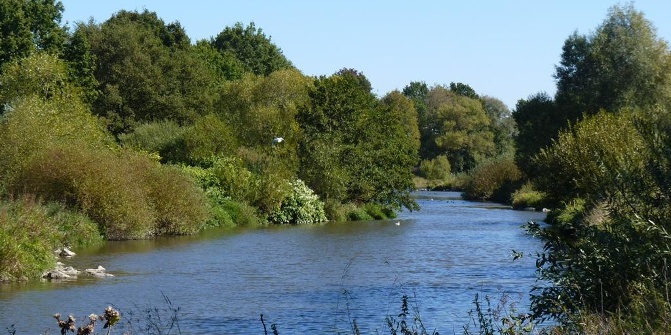
|
The fitness route starts at the swimming pool in Pfarrkirchen, then heads west and circles the Rottauensee, ending right back at the pool. The long route is suitable for sporty Nordic walkers but also for people interested in spending some quiet and relaxing time in nature. The scenery of the tour along the Rott is quite impressive, and the high variety of the terrain throughout the route challenges the abilities of the user. A heart rate measuring station is located on the eastern side of the lake near the dam. The route has a total distance of 10,7 km, but shortcuts can be accessed along the way. The total duration of the track takes around 2 hours and 20 minutes at a Nordic walking pace, but with cycling or running the time is significantly reduced. The elevation of the track is of 27 hm and is exactly equal to the descent since both the starting and ending points are at the Pfarrkirchen Swimming pool. |
|
|---|---|
|
|
Victor Petcu • 10/2020
Climbing in Pfarrkirchen
For those who never considered trying climbing, here are some information about this wonderful sport that engages and exercises the entire body unlike any other sport. If you are interested in building a slim, toned but
strong body perhaps you should seriously think about joining the climbing and bouldering gym in
LaVita Pfarrkirchen
. They offer a cozy climbing gym with a designated bouldering wall that suits the size and the demand of Pfarrkirchen.
Climbing is a rather inexpensive sport, the only required equipment being a snug pair of climbing shoes, chalk, a chalk bag, a harness and a rope. The lifetime of the harness and the rope are especially long and have
to be replaced after years of wear. The shoes and chalk might have to be replaced more often, but nevertheless once or maybe twice a year if you are a hardcore climber.
The climbing gym in Pfarrkirchen includes various routes of different difficulty levels, ranging from easy 5a to difficult 8a. The grading of climbing routes is designed to be pretty intuitive growing in difficulty
from 5 to 8 and also from a to c+. For example, a 6a+ is easier than a 6b, or a 7a is more difficult than a 6c+.
During Corona time and especially now with the lockdown, climbing gyms aren’t always available, so here are some exercises that will keep you in shape and also strengthen your body for when you will be ready to climb
again. The most important part of the body when it comes to climbing is definitely the upper body. That is why the exercises that will be presented bellow will mainly deal with the upper body and a bit with the core.
- Pull ups (enhance your back muscles and depending on the grip also the biceps)
- Push-ups (for chest and triceps muscles)
- Biceps curls
- Triceps dips
- Plank and side plank (for strengthening the core which helps your body positioning during climbing)
Climbing is a sport that requires quite a bit of warm up before each session, due to the fact that the entire body is being engaged in the process. If you neglect warming up before climbing, you risk getting badly injured and having
to recuperate for a couple of months (trust me, from personal experience). Warmups should usually raise your pulse and put your body parts into motion.
- 2-4 sets of 10 push-ups
- 15 bodyweight squats
- 30 sec arm circles
- 20 sec wrist circles
- 7-10 min on-the-wall warm-up (climbing easy boulders)
Victor Petcu • 11/2020
Get to know Pfarrkirchen! Best places to walk, jog or bike around the city!
Summer is coming, and we can feel it in the air. Longer days (thanks, summer time change!) warmer temperature, and a feeling that winter is finally ending.
Although we are still on lockdown due to the ongoing covid-19
pandemic, and therefore social distance, hygiene and contact rules, should be respected at all times, doctors
recommend to leave your house for at least 30 minutes per day, in order to free your mind and work out / do some exercise.
This should not be done if you have flu-like symptoms, or feel exhausted.
One of the advantages of living in a small town like Pfarrkirchen, is that there’s plenty of space and places to exercise freely. Here are some of them:
1- Rott River
If there is one peaceful, beautiful place to go for a quiet job or walk, or even ride your bike (not for a long way) is alongside the Rott river, just behind Aldi supermarket. Some of the features of these area are
rest areas, a side to walk or cycle, beautiful views of the river and an internal amphitheater.
2- Rottauensee lake
Probably one of the most beautiful areas in Rottal-In, this lake (halfway between Postmuenster and Eggenfelden) is great for running, walking or cycling alongside.
It also has great rest areas, which are perfect for a quick stop to drink some water and refuel energy before continuing your way.
During summer, it is common to see barbecues and picnics in its green areas. Again, during these times is better to refrain yourself from those activities as much as possible, and always remember that you are only allowed
to meet one other person from another household.
3- Postmuenster
This small town near Pfarrkirchen offers nice green, rural landscapes to cycle or walk around, specially if you want to avoid larger crowds.
4- Way to Degernbach
Pfarrkirchen, as every town, is divided in areas.
Most of ECRI students and Pfarrkirchen residents live around the city center, Zieglstadl, Gartlberg or Schalldorf areas.
Degernbach and Oberham, in the limits of
Pfarrkirchen, are less known, but equally beautiful and interesting areas: More rural and open fields than in the Pfarrkirchen areas, if you cycle all through the Passauer Str. or along the Bahndamm; you can arrive to this
little town surrounded by nature and green areas.
If you like these options, don’t forget to check our already made tours around Pfarrkirchen and Eggenfelden, in this same section below.
We hope that these ideas will inspire you to get to know the area a bit better!
Ayelen Toscano Juanes • 09.04.2021